#life series gem is all about agency!!! and control
Explore tagged Tumblr posts
Text
gem dying in wild life due to a total collapse of her attempt to maintain control of everything is a fitting conclusion to the thematic through line of her wild life character vs it's a real shame that she died in the finale of a pvp series to a randomly spawned mob
#geminitay#wild life smp#wild life#wild life spoilers#life series#life series gem is all about agency!!! and control#thats her defining theme#and this represents her loss of it despite how hard she tried to maintain it throughout wl#the collapse of her persona of control#however also it kind of sucked as a death
222 notes
·
View notes
Text
After Future, I think Steven’s situation is that he used to enjoy being compassionate, but then everyone’s expectations kind of ruined that for him. The dude is naturally kind and wants to help, but that desire of his got mixed in with the neglect and abuse from the Crystal Gems, from being used as an emotional crutch; And so something that was once his choice turned into, like... An obligation for Steven that he felt was his only sense of self-worth.
And even after clearing things up and moving forward, Steeb’s likely going to hesitate every time he helps a person, because now he has to ask himself- Am I really doing this from the goodness of my heart, is this actually what I want? Or do I just feel like I HAVE to? And this thing that brought him purpose, something he once chose, has had its agency stripped from him, there are so many traumatic strings and potentially unfortunate implications attached.
Steven’s not entirely sure if he’s being compassionate because he’s doing it on his own terms now (like those Gems repeating what they did best in Guidance), or if it’s because he thinks it’s the only thing he can do! And that just kind of ruins and sours the whole experience for him, he’s afraid to experiment because Steven’s not sure if he actually prefers this new thing in life, or if he’s trying to tear himself away from something he does love because he thinks it’s still being forced on him; And he’s just bound for a LOT of soul-searching going on out from here.
I can see Steven asking gems like Bixbite or Larimar for help, as people who DID go through a similar dilemma, again as a callback to Guidance; Which could’ve served as potential foreshadowing for Steven’s soul-searching journey he embarks on, by the end of the series. Maybe he’d feel guilty about asking for help, after messing THEM up- But in a way, he’s inadvertently helped them figure out the answer to whether they were just defaulting on old habits, or were genuinely happy with what they were doing.
Which, that could spiral into a whole ‘nother discussion on how people are influenced and if we’re really doing what we want, if we’re only the product of external factors; Have we even really chosen because we were programmed for it, is there free will and agency at all? Or must we just accept that yes, some things DO influence us and that’s okay, we can still make choices where we can. We can’t choose and control everything in life, sometimes you just gotta accept and work with what you have, so you can find the freedom to really explore!
Once more, Steven can realize what he already helped others learn... And I think it can help him come to terms with himself, what’s already said and done, and set in stone; But instead of being caught up and stuck in the immovable past, Steven can instead explore the ever-malleable Future that he has a hand in, and explore that freedom of choice and expression that his mother always wanted for him! There’s definitely going to be an identity crisis as Steven affirms that he always naturally did like to help people, it was initially his choice.
Maybe somewhere along the way, he has to realize that, perhaps, there is not as much of an ‘innate Steven’ as he thinks there is... That what he does like and enjoy, is actually something that he must decide for himself- Which is in some ways terrifying, but ultimately freeing, and I think in line with what Gems who broke free of the caste system eventually figured out. To what degree is compassion and helping others, Steven’s genuine choice and enjoyment in life? Perhaps that’s something only he can decide for himself, in the end; He can choose from here if it’s indeed his choice, if it’s just a burden forced onto him, to what scale in-between it is, it’s not at all set in stone; He can make his reality as he chooses it, perhaps.
166 notes
·
View notes
Text
The Act of LordE: Part-7
Rehabilitation
~ Bakugou & Izuku x Reader
Summary: [y/n] moves to her dream city having abundant hopes. Her encounter with Katsuki Bakugou, sends unsettling ripples through her life. Determined to earn an apology for her boyfriend, Izuku Midoriya, she gets into a game with Katsuki. Will the game remain a simple game even at the stake of her love life?

<<Previous
A/n: You will enjoy this better if you have read the previous parts before! ^^
Part-1 | Part-2 | Part-3 | Part-4 | Part-5 | Part-6 |
--Start--
A promising hero student losing his quirk was all over the news. The government had assured the nation of wiping out any sign of the evil product, down to the villains behind it. But this event made the public question the efficiency of the heroes and the government. The incident ignited by a local gang of thieves had created quite a stir.
Anyone who knew [y/n] could tell. She was the most disturbed, and a pang of uncertain guilt always clouded her face. [y/n] felt the most pathetic at work. It killed her to work in the absence of a man who, at the expense of something more important than his life, had saved her. The blame she held on herself became a hundred times heavier every second at the agency. She would feel a heavy lump in her throat, making it hard to breathe, as if the world was telling her she didn't deserve the air. She would end up fainting or break down. The agency had extended her internship by another month. So she can rest and recover well from the incident. She missed being busy, but she knew the agency was right.
”You cannot go on like this!” Izuku expressed his concerns on the way back from picking her up from the agency. She had been staying over at Izuku's since that day. He insisted that she did.
A week later...
The sun was already set, and the street lights illuminated the way. Izuku walked home faster than usual.
'[y/n] has to hear this now!'
he thought. He had to see her in flesh and blood. He had to see her shed the worries. He had to embrace her and tell her everything was going to be okay, indeed.
[y/n] was woken up by the sound of door unlatched. She sat up to welcome Izuku.
"Hey there, sleepyhead." Deku greeted in his usual warm tone.
"Hi, Izuu." [y/n] greeted him back, bringing her palm close to her mouth, yawning.
"Guess who visited UA University today?" Deku's eyes were dilated to adjust the dim room and, the street light reflecting off his green pupils made them shine like precious gems.
"Who?" [y/n] questioned him back as the ritual went, clearly uninterested.
"Aizawa-sensei!" His eyes went wide.
"Oh! your home-coming teacher?" [y/n] was more attentive now. She stood up, reaching the switchboard to turn on the lights.
"Yes! and Eri-chan too!"
[y/n] knew Eri. Deku had told her everything. She hadn't slept the day Deku told her Eri's story. She felt sad for the horrible things that little girl had to go through. She had even visited Eri once. [y/n] felt better looking at Eri doing well. She had been preparing for UA high entrance exams, determined to follow her beloved Nii-san's(Izuku's) footsteps.
"Hope she is doing well." [y/n] was smiling involuntarily at the mention of Eri.
Deku went on without feeling the need to assure [y/n] about Eri' well being.
"The reason they were there is.." Izuku tried to give a dramatic pause which miserably failed.
".. to discuss Kachan's revival!" He almost squeaked.
Eri's quirk let her transform anything she touched into its former form. A dangerous yet powerful quirk if learnt to control. But, it was never used as Eri was yet to learn how to control her power. Besides, Aizawa and other pros were against burdening her with such huge responsibilities. She was just a kid, after all. But, this time, Eri had volunteered. She had grown beyond feeling her quirk was a curse that took her parents and everything else from her. She knew her true power lay in returning something that was taken away. Surely, she couldn't revive what was taken away from her but, if she could do it for others, she wasn't going to sit back and watch. After testing her in and out, Aizawa had decided that she might be able to succeed.
"Eri's quirk!" [y/n] exclaimed. She slumped in to the sofa and let out a huge sigh. Knowing that there was a possibility that Katsuki could get his power back changed the world for her.
Izuku and [y/n] were in bed. They had had a cheerful dinner. Izuku must have mentioned at least a dozen times how happy he was to see [y/n] smile again.
"Will you visit Kachan at least now?" Deku casually questioned, staring at the ceiling.
[y/n] remained silent. Deku grunted as he shifted to face [y/n].
"[y/n]-chan" Deku then patiently waited for an answer.
"I will go tomorrow." [y/n] finally responded, her response almost inaudible.
Katsuki hated having visitors. He hated them trying to sympathise, trying to give him false hopes and the way they looked at him as though he was a helpless pup. He hated it the most. When he tried the hardest not to think about the future, all their visits did was remind him that. Luckily the glass chunks hadn't pierced deeper than a few muscle layers. He had argued with the doctor to let him go home soon. The doctor had patiently explained that he had to be kept under observation for at least a week, for he had been struck with way too many quirk erasers.
Katsuki was sleepy and tired all the time. By the time [y/n] visited him, he was a lot better. He could read a JUMP and even walk around the room before his eyelids felt heavy again. When [y/n] entered the room, Katsuki didn't recognise her anymore. The face otherwise filled with resentment and disgust was filled with gratitude and kindness with a hint of guilt. Katsuki wasn't sure how he felt about this transformation. [y/n] forced a smile as she nervously walked to his bed. She had begged Izuku to go along. He had refused to, saying she had to do it herself.
”Besides, Kachan will only be ruder to you with me around, ” he had joked. Little did he know that Kachan was hardest on her when alone. Kachan was more confused than ever. Unsure of how to react, he reached for the water glass set next to his bed. He gulped down the water hurriedly, ending up coughing and spilling it all over him. His body wasn't recovered enough to keep up with his speed. He should have known. [y/n] quickly took her handkerchief out and started dabbing the dampness as she took away the glass from him. She didn't look up until she felt his grip on her wrist. It was weak physically yet, she froze.
"I...I.."
"Don't you dare," He hissed. [y/n] was confused.
"I was just..."
"Shhhhh.." He stopped her midway and pulled her closer. Her face inches away from his.
"Can you not.." He muttered, searching for words, looking away.
"I am sorry" [y/n] didn't know why she was apologising. For dabbing his chest without permission? For his quirk?
Katskuki submerged in the way the air hushed out from her mouth tingled his skin, neglecting her words entirely.
"Bakugou! How are you feeling today?" The overly enthusiastic doctor entered the room.
[y/n] and Katsuki quickly parted. Katsuki let out a sigh, half thankful for the intervene.
"I am okay." He didn't quite return the doctor's energy.
"You can leave." He muttered, looking at [y/n] from the corner of his eye.
"The madame can stay. I will hardly take a minute. " The doctor beamed as he plugged the stethoscope to his ears, clearly aware of his intrusion and bad-timing.
"Um, I will come by later, I guess. Bye." [y/n] almost ran out of there.
She let her head sink in her palms. She hadn't done a single thing she had rehearsed. Thank him, ask him how he was, apologise and mostly, mostly to start fresh.
Next>>
~ Click here to be a part of my Taglist for this series
~ Click here for the series masterlist.
~ Click the bear to check out my other works:
ʕ•ᴥ•ʔ
———————————————————————Taglist: @nervousmentalityfox , @marvel-love-posts @miraclecherryblossomsblog , @sssjuico10 , @fuzzzwald @omlbarnes , @spicy-therapist-mom ———————————————————————
#my hero academia#boku no hero academia#boku no hero fanfic#bakugou katsuki#bakugou fluff#bakugou x you#bakugou x y/n#kachan#mha katsuki#bnha katsuki#izuku x y/n#izuku x reader#izuku x you#midoriya x reader#midoriya x you#katsuki x y/n#katsuki x you#katsuki x reader#mha x y/n#mha x reader#dekusquad#bnha bakusquad#bakugou smut#bakusquad#midoriya izuku#midoriya izuku x you#bakugou katuski x reader#boku no hero x y/n#boku no hero x you#my hero academy fanfiction
26 notes
·
View notes
Text
I’ve written a lot about the abuse and loss of agency of Marvel’s lesser known Russian heroines. You can check my tags on STARLIGHT and FANTASMA and DARKSTAR to see these. Today, I’d like to talk about the other Darkstars. While Laynia Petrovna was dead, the Russian government had another woman fill her place in The Winter Guard, and then a second replacement when the first died. Neither of them were exploited to the degree any of these others were, and in fact weren’t exploited at all---their participation was fully voluntary. So their stories aren’t comparable to the original Darkstar, nor to Starlight and the others. But the shortness of these stories, how they ended, and how neither woman is remembered at all despite her sacrifice, is still sad to me, so I wanted to post about them anyway so someone else would know them too. When these women signed up to be Darkstar, they didn’t just take on her name and costume. They were genetically altered with her DNA, and given the gem that she’d used to magnify and amplify her Darkforce abilities. This combo allowed them to use the same abilities. What’s more, they were modified to look like her as well; it’s hard to tell if they were meant to be exactly identical to her or not, since all the women in comics tend to look the same but with different hair, but they did at least all have a very strong likeness, and it wasn’t due to a natural coincidence. Rather eerily, we know nothing about what they looked like before, though Reena claims she was fat and ugly before. The second Darkstar’s real name was Sasha Roerich. As a “young pupil” (she never says a pupil of what) she dreamed of serving her country like the the Bogatyrs of East Slavic legend. She believed that serving in The Winter Guard would give her that opportunity. However, after her modification, she came to believe she had been wrong. She came to regret having the DNA of a dead woman inside her, saying that “sometimes I can feel her crawling around inside me”. These were not mere delusions either; she actually began experiencing Laynia’s memories. She believed that The Presence had something to do with it. He had decried her as an “imposter” of his daughter, the original Darkstar, when they met, and had demanded “If you really want to honor my daughter’s memory, why not just become her?” as he blasted her with an unknown force, and it seems that her flashbacks as Laynia either began after this, or at least got worse. She pressed him for answers in his holding cell. He says he’d been remolding her genetic structure when they fought, but while he was doing that, he’d discovered that Laynia’s lifeforce shared a symbiotic relationship with her gem, the gem that Sasha had inherited, bonded on a subatomic level. He told Sasha she was now “simply a biological unit housing a power beyond your comprehension. You’ll never have her strength. Your fate is written.” He was correct, despite Sasha’s anger at this response, as she believed he was merely saying she was not heroic enough. Immediately after this, her power went out of control, transforming her into an eldritch creature of pure Darkforce energy---and a hostile, mindless one at that, no longer Sasha Roerich at all, nor the hero Darkstar. Her own teammates were forced to destroy her. The Russian government immediately created a new Darkstar, giving her the same gem. Her name was Reena Stancioff. Like Sasha, we know nothing of her past except what she tells us, and it’s very little--she confides to a teammate that she grew up “fat, ugly, and unloved” and that she became Darkstar because “I wanted a better life for myself.” But like the unfortunate Sasha before her, Reena found that it wasn’t what she had hoped-- “The technology here, it changed me [. . .] I have this beautiful body, this great role as Darkstar, and everything. But ---I have incredible darkness twisting like a corkscrew inside of me.” Despite Reena also feeling that she wasn’t going to be good enough, she also began to show a level of power that Laynia never had, such as being able to teleport an entire airship. Perhaps this was an early warning sign she was fated to meet the same end as Sasha. But we’ll never know, because the Dire Wraiths got her first. Dire Wraiths are shapeshifters able to take on the forms of their victims, and the one that killed Reena immediately took on her form, allowing her to access the abilities of the Darkforce through the genetic link to the gem. But this backfire---as the Presence had said, Laynia’s lifeforce was bonded to that gem, and it took over the Dire Wraith’s body, transforming it permanently back into her own, and bringing her back to life. The original Darkstar had returned. It is unknown yet if taking over the body of a Dire Wraith also gave her any of their abilities. Most the team was happy to see her, of course. But the current Crimson Dynamo (a codename that also sees a lot of different bearers) aka Galina Nemirovsky, the teammate that Reena had confided her insecurities in, was not fond of the idea that Laynia had come back “inside the body of a brain-eating abomination, hiding in plain sight among us” while “to the rest of the world, Reena dies unknown and unsung. A star that vanished before her time.” Which, I agree with her on. I love Laynia. I also feel terrible for Sasha and Reena. And I think they should be remembered too, hence this post. Both these stories were told in the “Darkstar and the Winter Guard” series. The titular Darkstar is in fact not Laynia, the Darkstar that most people are familiar with (if they know the name at all), but mostly Reena. Sasha is the Darkstar of #0, which ends with her death and Reena’s induction. Reena dies in #4, the final issue, in which Laynia is also revived mere panels later. So all the Darkstars appear in it---just they’re never alive at the same time. Which is a shame.
#Laynia Petrovna#sasha roerich#reena stancioff#darkstar#darkstar and the winter guard#The Winter Guard
14 notes
·
View notes
Photo


Let’s talk about chapter 81
I have a fondness for anticlimax humor, so I found this chapter to be pretty hilarious, alongside all the heartbreak and intrigue. This woman threatens to dump the ending of Eva on us, keeps us in suspense for a month, only for Phos to be too much of a klutz to bring about third impact. It reminds me a bit of the bait and switch with Shiro. I love it. This bit was great too. After keeping his duplicity in the realm of subtext for nearly thirty chapters, Aechmea just comes right out and says, with a flummoxed expression, that he has more terrible secrets than he could possibly explain within twenty minutes. Ichikawa went right for my jugular.
Many others have already written at length about how Rutile’s attempt to find purpose in repairing Padparadscha has completely ruined their relationship and made Rutile a worse person in the process, so I won’t retread that old ground. But, I would like to reiterate that this attitude is a reoccurring and prominent thread of the story. Bort found purpose in protecting their beloved Dia, but in their zeal, they drove Dia away by making them feel like a useless burden, by expecting them to be content with existing as a mere object of protection. While Aechmea doesn’t seem to find purpose in Cairngorm, he does act entitled and possessive towards them, would greatly prefer it if Cairn acted like a passive trophy wife 100% of the time instead of just 85% of the time, and generally pushes back whenever they try to do anything remotely proactive. And who can forget that time he pitched a fit when Cairn actually went against his wishes.
Phos is one of the few to buck this trend. Their reaction to the debacle with Cairn was pretty even-keeled, especially considering that they don’t know what went down in chapter 67. They’re clearly bitter and hurt, but they still took Cairn’s advice to heart, and also asked if they were okay before leaving for earth. And in this chapter, we got some insight into how they feel about their other failed relationship. At first, they reached toward the clipboard with a look of desperation. But, in the moment that they realize Cinnabar has left both them and the promise that gave them purpose behind, there is no desperation or rage—only resignation. The typically implacable Phos admits defeat without a fight. It’s a deeply sad moment, but the way Phos refuses to let their feelings curdle into spiteful entitlement is downright refreshing. This could be considered another parallel they share with Kongou, who is also very accepting of other’s choices and desires, even to his own detriment.
Anyway, hopefully this is a turning point for Rutile so that they’ll snap out of their terrible attitude and rethink their life, or something.
In chapter 72, Cairn offhandedly mentions they have no idea what Aechmea is talking about most of the time, and that they prefer to keep it that way. This was the first of several hints indicating that they’re kind of terrified of finding out what Aechmea’s deal is. In particular, this line from chapter 75 seems to have really rattled them—they’ve brought it up several times now, and it’s been on their mind even after the long time skip. When Cairn thinks they’re about to die without learning the truth, they confront Aechmea directly, but the second that Phos messes up, they back down and return to more trivial topics of conversation. (This is also the moment the moe eyes return after being largely absent for a chapter and a half.)
Their line here is a callback to what Aechmea said in chapter 78, and probably a deliberate one on their part. If I were to read between the lines, I think what they’re really saying is something this: “I know I’m not getting anything out of you at this point, so I’m not even going to try. Also, I’m going to pretend everything is fine and that this debacle never happened. Secrets? What secrets?!” As per usual, they’ve taken one step forward and two steps back. But, as much as Cairn might wish they could, they can’t un-open Pandora’s Box. I will say, though, that I’m a little nervous about what lengths they might go to in order to keep things as they are, so that they don’t have to face those potentially awful truths.
(Y’know, I can’t help but see some parallels in my own emotional reaction to this series. On one hand, I really want to know what happens next, and where Ichikawa is going with all this, but at the same time, I kind of want to remain ignorant of all the strife to come, and instead escape to some 500k slowburn cinnaphos coffeeshop AU. It would be so much less stressful if Phos were breaking the espresso machine* instead of my heart.)
Anyway whatever this secret is, I suspect it might re-contextualize chapter 67. Ichikawa seems to value the agency of her characters a lot, and the plot tends to progress because of choices instead of contrivance or coincidence (more on that in a moment,) even if it means that those choices make a previously popular character less sympathetic. With that in mind, I doubt Ichikawa intends for Cairn to get away with abdicating responsibility for every choice they made before chapter 68.
For the past handful of chapters, Phos has seemed pretty suicidal. So, it’s interesting that even after saying they’ve lost the will to go on, they nonetheless ran for their life when the others started chasing them, instead of throwing in the towel and simply letting themselves be shattered. It seems like they still have some fight left in them, even if only subconsciously.
Speaking of Phos’s subconscious, I’ve saved the aspect of this chapter I found most fascinating for last—the way in which the apocalypse is averted by Phos, uh, knocking over a table and making too much noise with their spider-limbs. This is pure speculation, so take it with a grain of salt, but I think it’s possible that Phos alerted the gems on purpose. According to what Aechmea said last chapter, they’ve been looming over Kongou for two whole hours, so it seems a little odd that they’d lose their balance now, at the last possible moment. While it is, as I’ve stated earlier, totally hilarious, this turn of events is a little too convenient, especially for a story that’s so aggressively character driven. As I wrote in my last essay, it’s most fitting that this moment comes down to Phos or Kongou’s choice, so I’m inclined to believe that is, in fact, what happened. I also think it’s quite possible that this act of self-sabotage was subconscious, like some events earlier in the story such as Phos’s out-of-control legs, or the cage made of their arms.
Furthermore, remember how Phos came to earth this time around with the hope that Euclase would be willing to hear them out? Well, if this blunder was, in actuality, a veiled cry for help, then their original plan has actually come to pass, just not in the way they were expecting—which is kind of the story of Phos’s life. (Man, it feels weird to try and adjust my brain to Euclase-stan-mode.)
Regarding the framing of the scene, we only see the moment Phos trips from Aechmea and Cairn’s perspective, and we don’t get a clear look at the action until the table has already tipped over. That Ichikawa chose to compose the scene in this manner leads me to believe there’s some sleight of hand going on here. Not to mention the fact that we’re not privy to Phos’s thoughts for the entire chapter, and it’s a little hard to parse their expressions when their face has been pureed.
Assuming my interpretation is correct, if I were to take a stab at why Phos backed out, it would be this:
A. They can’t stand looking at a snail in pain for five seconds, so watching Kongou stare up at them for two hours with the expression of a ewe watching its lamb ride off to the slaughter house might have been more than they could bear.
B. It’s been established that they already suspect Aechmea of withholding information, so perhaps they’re hesitant to give him what he wants without knowing the consequences.
Like I said, this is merely a possibility…but if it is the case, I would like Phos to know that I am very proud of them.
And finally, a few little observations that don’t fit in anywhere else
Judging from context clues, it seems that after Padparadscha was cured of their mercury poisoning, Aechmea removed their replacements, hid them away, and told the others that they were dead, or something. What a dick. The question is, why did he do that? They have shown themselves to be much more canny and goal-oriented than the other gems on the moon, so maybe Aechmea didn’t want someone like that around, and used the opportunity to get rid of them. But, who knows?
In chapter 79, it seemed like there was a huge hole in Phos’s torso, but in this chapter, what pieces are missing seems to change from drawing to drawing, so ¯\_(ツ)_/¯.
Regardless, there are consistently huge chunks of their head and legs missing, and the earth gems are unlikely to just give them back, so it’s likely they’ll be replaced. Their replacements are just as much a part of the Phos we’ve come to know as their original material, so the prospect of losing even a part of those replacements is rather sad. Those legs were gifted with love, dammit!
My boy cicada came to save Phos :,). IIRC, Cicada and Ventri are the only characters who have given Phos a hug over the course of the story, and are thus the only valid members of the supporting cast. Padparadscha is also allowed into this exclusive club for giving Phos a very comforting head pat.
Bort has started wearing powder on their left leg again.
Amethyst(?) brought a rope along. Like this is some sort of Phos-rodeo. Hilarious.
*bonus points if the espresso machine is nicknamed “sensei”
30 notes
·
View notes
Photo
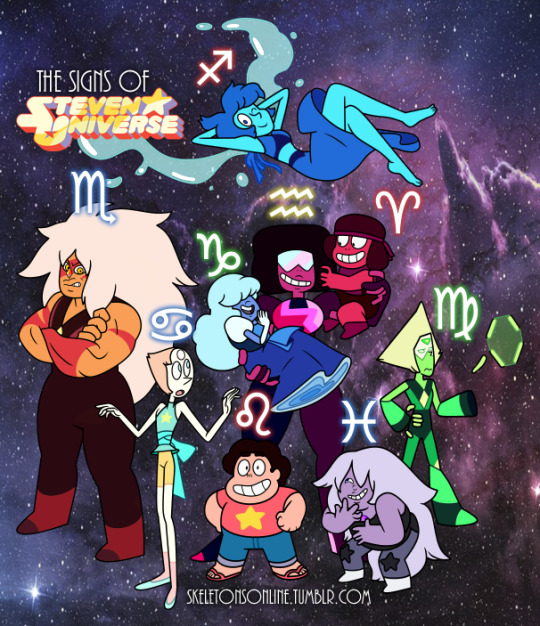
The Signs of Steven Universe
Steven : Leo - The only gem to not match their stone’s metaphysical astrological associations, which makes perfect sense because he’s NOT Rose Quarts OR Pink Diamond, he’s Steven! Leo is the sign of the ego, of self discovery and identity formation, a huge theme in the series. Leo as rules the heart, and if anything, a Leo’s super power is friendship and loyalty. His shield is shaped like the astrological Sun glyph. Pearl : Cancer - Closed off yet over protective, cancers have many layers to peel back before their true emotions show. Quick to anger but hard to reach, like a crabs touch exterior equipped with scissor like claws. Pearl’s spear is a perfect example of keeping distance while still taking on the fight. The placement of her gem, her forehead, is reference to the High Priestess. Just as Steven traveled through her memories, the priestess reveals many untold secrets.
Amethyst : Pisces - Rude and crude, but empathetic and caring. A Pisces is one to either die for dogma or to strive for spiritual freedom, and nobody rejects the mold more than Amethyst. Her whip is a symbol of the Pisces, two fish swimming in opposition, yet eternally tied together by the umbilical cord.
Garnet : Aquarius - The perfected balance of self control and stability. Aquarius is the distant leader, one who values rationality over emotional excitement. Quite, almost shy, but stern and sure in themselves. Aquarius is the fountain of knowledge being poured out into the world, an Garnet’s gauntlets are the jugs carrying the water of truth. Aquarius is also the rebel, one who rejects the practice of society but still holds it’s universal morals close. In this way, Aquarius is closely associated with the sexual and queer liberation movement, just as Garnet was the first cross fusion to ever exist. Ruby : Aries - Hot tempered lover! Acts first, thinks later. Fun and exciting, but don’t her get a head of herself.
Sapphire : Capricorn - Capricorn is always planing and thinking about their future, not at all unlike Sapphire’s future sight. Peridot : Virgo - Too much attention to details will drive a Virgo to stubbornness and self oppression, but once that habit is broken, an artist is born! Ruled by mercury, Virgos love to communicate, observe, study and engage in both a piratical and intellectual level. They often assume more responsibility than is reasonable, and may take rejection of ideas as personal insults, but deep down they just want to serve and make others happy and comfortable. BONUS - while i currently cant find any connection to metal, beyond my own unverified theories of symbolism, I recognize Magento (X-Men) as a Virgo archetype, so im sure im on to something with that, haha.
Lapis Lazuli : Sagittarius - Strong, independent, powerful, and completely and utterly unsure of themselves. Sagittarius value their freedom and personal agency above all else, and often reject and fear ideas of commitment in all forms. This plays out in Lapis’ character arc - confined to the mirror, imprisoned on home world, trapped with Jasper, and then stuck on Earth. Due to these fears of being “locked in” without choice of freedom, Sagittarius is quick to flee, which vibes nicely with their desires to philosophize, travel, explore and learn. This is representing by her wings. She also resembles the figure from the tarot card “Temperance” which features an angel pouring water from one cup to another, the water symbolizing the emotional and spiritual alchemy that they strive to internally balance. Jasper : Scorpio - Death, Sex, Rebirth and Transformation, these are the eternal themes of the Scorpio archetype. Scorpio has the tendency to self oppress by holding themselves to impossible standards, while refusing help from others and isolating themselves by expecting the impossible from others as well. Scorpio, in her lowest aspect, as a controlling and hostile nature. Jasper fits all these themes, eventually to her detriment of transformation via corrupt fusions. Scorpio is ruled by both Mars and Pluto, with Pluto’s helmet being the inspiration for her own crash helm. BONUS - Not trying to hate on Scorpio, they aren’t evil people, well not any more evil than anyone else is capable of, just an internally conflicted incarnation. Another Scorpio in SU is Lars (get it? Lars/Mars? haha) and although he is a major prick, his aggression is a reflection of his own insecurities. His story is currently turning around though, his physical death and resurrection parallels the metaphorical death a Scorpio must experience to live - to relinquish control and submit to life, learning to live with the universe and not against it.
-----------------------------------------------------------------------------------------------------------
There are so many more I wanted to include with this, but for now I’ll just stick to the main cast of Gems. I plan to do a list of all the other gems and the beach city residents too! Follow for more Astrological Archetypes in Pop Culture, and other Metaphysical & Esoteric topics!
#SkeletonsOnline#astrology#zodiac#signs#steven universe#cartoon network#crystal gems#crystals#garnet#amethyst#pearl#jasper#peridot#lapis lazuli#ruby#sapphire#leo#cancer#pisces#scorpio#aquarius#capricorn#aries#virgo#sagittarius#metaphysics#astrology memes#zodiac memes#esoteric#occupied
128 notes
·
View notes
Note
So! Rose Quartz was the leader of the rebellion that fought the Diamonds and the Gem Homeworld to protect life on planet earth, as it was going to become a colony owned by Pink Diamond. She is basically the reason the earth was saved, but, in consequence, basically all the gems in the rebellion "died", her 2 closest friends and herself were the only ones remaining.
When it was revealed that she was Pink Diamond all along, people thought it invalidated the only good thing she had done, and then died *on purpose* to leave the burden for her son to deal with. As the series went on his son learns how in her past as a Diamond she did horrible things to other gems, including her closest friend, who had been her personal servant, but we also see the trauma caused by the other Diamonds that led her to take these decisions. The funny thing about it is that the theory had also started as a kind of joke very early on!
To summarize: character that was thought to be flawless and perfect and that died sacrifizing herself so that her son would live was revealed to not be actually flawless and perfect, and, in fact, did some fucked up stuff after centuries of abuse/trauma. People took only the bad stuff she did and made it define her character completely without taking the circumstances into consideration. (Also somehow calling the creator, a Jewish nonbinary woman, a Nazi Apologist).
The reveal that Adrien is a sentimonster is causing similar reactions, people think him not being fully "human" invalidates everything he's gone through, that his feelings and trauma are fake. What happened in Ephemeral, with him being unable to disobey his father and causing the end of the world, shows a lack of agency: they see Adrien as just a puppet that could be controlled by anyone in possesion of his ring.
@gentil-minou has written great stuff explaining how this isn't the case, but yeah.
Adrien might make some bad decisions in the future while being controlled by the ring, or even by himself, when he realizes he's a sentimonster and what that implies about his own existence.
And some people will probably be very mad that his character reacts realistically to such a traumatic situation, especially the people that see him as a perfect angel who can do nothing wrong.
Ah, thank you for that explanation!
1 note
·
View note
Text
Next Car Game Tech Demo Download
Communications
Editing
File Management
For Developers
Gaming
Internet Tools
Operating Systems
Optimization
Players
Productivity
Security
Miscellaneous
Android
Device Drivers

Welcome to Azeroth, a world of magic and limitless adventure. Experience the ever-expanding fantasy of World of Warcraft for free today.
November 14, 2020
Freeware
Windows
Comprehensive, powerful flight simulator, and has the most realistic flight model available for personal computers.
September 29, 2020
Demo
macOS
Relive the classic Quake II, now with real-time ray tracing.
January 6, 2020
Freeware
Windows/Linux
Fast download for the InSomnia Tech demo. This RPG is set in a Brutal Dieselpunk Universe. Atmospheric single-player/co-op RPG set in a 'living' dieselpunk sandbox with real-time tactical gameplay.
July 10, 2014
Demo
Windows
Redline is a racing game for MacOS X that demonstrates just how much fun tossing polygons around at 200+ mph can be.
December 6, 2013
Demo
macOS
iConquer is an addictive game of world conquest, played by 1 to 6 players.
July 4, 2013
Free to Try
macOS
Transport a vast variety of cargo across more than 60 European cities.
December 6, 2012
Freeware
Windows
Try the new Pro Evolution Soccer 2013, also known as World Soccer: Winning Eleven 2013 in Asia.
December 6, 2012
Demo
Windows
Snood is a fun puzzle game for Macintosh that will test your intellect rather than your reflexes.
April 30, 2012
Free to Try
macOS
Featuring two maps, two modes and four weapons. The Crysis 2 multiplayer demo is guaranteed to provide hours of first-person shooting fun ahead of the full game’s release on March 22nd.
March 1, 2011
Demo
Windows
Experience the epic sequel to the 2009 Game of the Year from the critically acclaimed makers of Dragon Age: Origins and Mass Effect 2.
February 23, 2011
Demo
Windows
A game that presents to you a 3D virtual world where you become a bug
January 20, 2011
Demo
macOS
Third-person action video game prequel to James Cameron's film of the same name.
November 22, 2010
Freeware
Windows
Batman: Arkham Asylum utilizes Nvidia PhysX, 3D Vision y SLI Scaling that brings Arkham Asylum to life.
November 22, 2010
Freeware
Windows
With CUDA and 3D Vision support, download this demo to get a taste of what Just Cause 2 has to offer.
November 22, 2010
Demo
Windows
Turn-based strategy computer game developed by Firaxis,
November 22, 2010
Demo
Windows
Grab your MREs and prepare to spend four days playing two new maps and modes for the multiplayer version of Medal of Honor.
October 4, 2010
Freeware
Windows
FIFA 11 reinvents player authenticity – on and off the ball – for every player and at every position with Personality+.
September 16, 2010
Demo
Windows
JongPuzzle it is the tile solitaire game similar on mah jongg.
October 28, 2009
Free to Try
Windows
Unique WWII real-time strategy game.
October 19, 2009
Demo
Windows
Make jigsaw puzzles from any picture and solve them in the screen.
October 7, 2009
Free to Try
Windows
Bejeweled 2 Deluxe will allow you to play the sequel to the classic gem-swapping puzzler!
October 7, 2009
Demo
Older Mac OS
You must line up 5 balls of the same color.
February 17, 2009
Free to Try
Windows
Create your own creatures for use in the upcoming strategy/sim game Spore.
December 18, 2008
Demo
Older Mac OS
Tank-o-box is a new action-packed remake of a classic arcade battle tank game.
December 17, 2008
Free to Try
Older Mac OS
Enjoy new storylines and explore massive environments not seen in the film with this playable demo for Wall-E.
August 12, 2008
Demo
Windows
Create your own creatures for use in the upcoming strategy/sim game Spore.
August 12, 2008
Demo
Windows XP/Vista
Duke Nukem 3D is a fantastic 3d shooter game
May 23, 2008
Free to Try
Older Mac OS
LucasArts has released a playable demo of LEGO Indiana Jones: The Original Adventures.
May 15, 2008
Demo
Windows XP/Vista
Atomic Cannon is a fun strategic tank artillery arcade game that is easy to learn but difficult to master.
April 24, 2008
Free to Try
Older Mac OS
Destroy the neon light beams before they reach the ground!
December 25, 2007
Demo
Windows
Remake of a popular classic game Bubble Bobble.
December 19, 2007
Free to Try
Windows
Control the stone frog idol of the ancient Zuma in this thrilling action puzzler.
December 3, 2007
Demo
Older Mac OS
Six classic games designed to stimulate the cerebellum and cajole the cortex!
November 29, 2007
Demo
Windows XP
Need for Speed: ProStreet (NFS:PS) is the latest installment of Electronic Arts' popular racing game series Need for Speed.
November 2, 2007
Demo
Windows XP/Vista
This Crysis demo includes one single player level, and the Sandbox2 Editor.
October 26, 2007
Demo
Windows XP/Vista
Midway and Epic Games announce that the beta demo for Unreal Tournament 3, the highly anticipated first-person-shooter.
October 23, 2007
Freeware
Windows XP/Vista
This demo puts you in the shoes of a second F.E.A.R. team investigating Armacham.
October 23, 2007
Freeware
Windows XP/Vista
An innovating,nervous, funny and colorful FPS: the real First Penguin Shooter
September 26, 2007
Demo
Windows
Billionaire II is a new thrilling and exciting business game
September 19, 2007
Free to Try
Windows
Enemy Territory: Quake Wars pits the armies of Earth against the invading alien Strogg in an online strategic shooter.
September 10, 2007
Demo
Windows
Lead the U.S. army in an attempt to reclaim its cities from a Soviet attack in 1989.
August 28, 2007
Demo
Windows XP/Vista
The BioShock PC demo allows you to play the game's first thirty minutes or so.
August 28, 2007
Demo
Windows Vista
In a war for Earth's survival against an unrelenting Alien enemy, the only way to defeat them is to become one of them.
August 3, 2007
Demo
Older Mac OS
Roll your marble through a rich cartoon landscape of moving platforms and dangerous hazards.
July 20, 2007
Demo
Older Mac OS
Try Munch a Bunch that is new twist of popular PacQuest 3D!
July 9, 2007
Free to Try
Windows
Play the Lost Valley level in the retelling of Lara Croft's classic adventure.
July 2, 2007
Demo
Windows XP/Vista
Attack an Akrik hive or an ice-pirate fortress in this sci-fi shooter demo.
May 29, 2007
Freeware
Windows XP
Attack an Akrik hive or an ice-pirate fortress in this sci-fi shooter demo.
May 29, 2007
Freeware
Windows XP
Find as a fallen angel against Etherlight, heaven's secret agency.
May 29, 2007
Demo
Windows XP
Next Car Game is a demolition derby themed racing game with sophisticated driving dynamics and in-depth vehicle upgrading, soft-body damage modeling, featuring both demolition derbies and more traditional track races. The game brings you epic crashes and tight, neck-to-neck fights over the finish line on run-down racing tracks.
Next Car Game: Wreck Fest is most likely the best racing game in terms of its realistic car destruction physics this generation we’ll see. While still being in alpha and gone through many iterations, it holds such high standards in its car destruction with tremendous details spewing from it, along side its great driving physics.
Speak of driving, if you’ve ever enjoy playing Flatout games before, then you’ll enjoy this one as it’s being developed by the creators of Flatout and it holds just as much care and love in its handling as much as its fun and amazing realistic destruction physics.
By pre-ordering the game now, not only you get to play right away but also have a chance to get a lot of cool exclusive extras like technology sneak peek 2.0, special supporter car and your name.
Drive Tech Demo is a high quality game that works in all major modern web browsers. This online game is part of the Simulation, Physics, Driving, and Download gaming categories. Drive Tech Demo has 183 likes from 223 user ratings. If you enjoy this game then also play games Hot Wheels: Stunt Track Driver and Russian Car Driver.
Download the tech demo by sign-up for the game’s newsletter here.
Get access to the alpha access here.
Next Car Game Tech Demo Free Download
Played it? We’d love to know what you thought about it.
0 notes
Text
Good Stuff - THE TROOF ABOUT STEVEN UNIVERSE - Part 2
WARNING: If anybody’s got a clown suitcase, I would very much like to see it. And here’s part 1, if you wish to know more. Thank you, take care out there, and enjoy.
Steven Universe is a charming, popular show with a quad-polar fandom, and I’m only here to point out what I say is legitimately wrong with the cartoon. Simple enough? Fair enough. Previously, I talked about how their action is so basic, it’s inexcusable. Now for Point number 2, which is also my favorite:
THE VILLAINS:

I fucking love villains. Not just for the who, but why and how they do it. When bad guys like the Joker, Lord Dominator, DIO, or Him do their thing onscreen, I enjoy every moment of their threatening essence (except Jared Leto’s Joker, he sucked). Villains remorselessly do unethical, downright vicious, things to fulfill their goals while initiating setting up the heroes to correct these effects with their efforts and abilities. Steven Universe has villains, sure. Yet, after having so many chances, Rebecca Sugardaddy has failed to make them REAL villains, specifically the Great Diamond Authority.
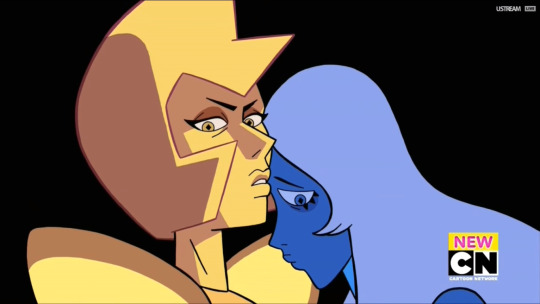
Now originally, I was gonna compare the Diamonds to the likes of Fire Lord Ozai (Avatar: The Last Airbender) or DIO (JJBA); villains that work in the shadows and when they’re eventually revealed, they’re already a force to be reckoned with. But looking into how they and Homeworld is set up, there was no other villainous ensemble that could stack up with the Diamonds perfectly like the Gorosei from the anime One Piece.
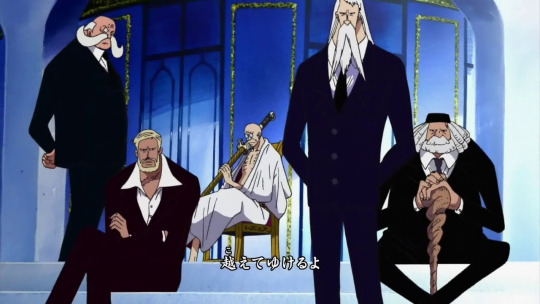
Looking more badass than the US Government
Now these five gentlemen aren’t necessarily what make up the end all be all for the series, but above all, the Gorosei are the ruling leaders of the organization that controls the entire world of One Piece. They command the military, the police, and other agencies, like their investigative and espionage departments, and the only people that out rule these gentlemen are the descendants of those who created it several centuries ago. Like the Diamonds, they seek to maintain order and justice for the people of their world and doing so means taking on any sign of revolution (namely Pirates) that could damage not only their image, but their purpose. Both Authorities possess absolute rule over the many classes that are under them and their stance of power can be present with the many actions that effect the characters we focus on currently. The difference between the two ruling classes is nuance, aka a grey sense of morality, aka an actual sense of relatability. So when I see a series having an overall narrative villain, Steven Universe has shown me that sympathy should NOT be a factor in storytelling.
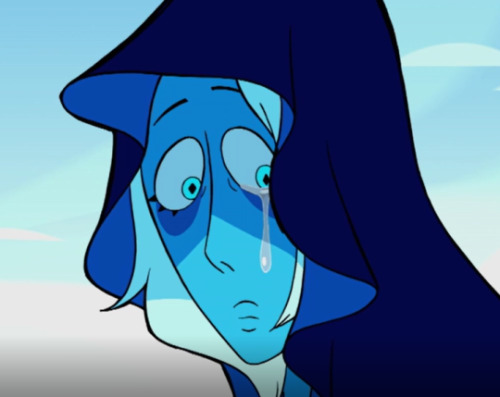
And their crocodile tears are not welcome either...
Now when I say this, I don’t mean you can’t sympathize with any villain you see. Most of the time, you can feel for the antagonist when their lives never were good to begin with, that’s namely how villainy starts out, therefore making their actions not so much justified, but understandable. Take the rogues gallery that are the enemies of Batman.
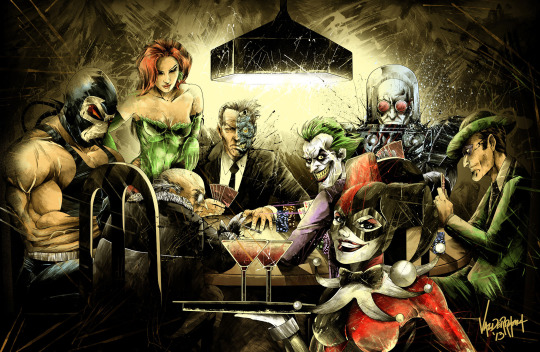
Every one of them has a story to tell and a method to their madness. Their histories weren’t as nice or as hopeful as they may have hoped, and you can feel their pain as their efforts to be successful at something grand falls apart due to the Dark Knight or life’s unforgiving nature. However, the sympathy stops there because none of these masterminds, with the Joker being an exception, serve as a main villain to Batman’s crusade for justice, they’re continuous rivals and one off stories that expand the DC Universe. No evil in Gotham is powerful enough because Batman’s story has no real endgame. Steven Universe and One Piece will eventually have an endgame. And while the Gorosei represent an Oligarchical commodity that separates its order seeking rule from their affiliating countries, The Diamonds have amounted to being under one system alone:

Yep. Nazis.
And it’s weird I bring this up. For I would’ve thought to have called Homeworld an authoritative caste system where the gem you’re born with defines your class and status, coinciding with the gems’ natural abilities. The specific gems are given a role and everyone plays a part to maintain societal order, like what India has, with the Diamonds being the biggest and strongest gems and therefore are the de facto Matriarch of the gem society, you feel me? That would’ve earned a little sympathy from me, because the Diamonds losing Pink would’ve meant the massive changes to accommodate their order and resources might not have worked out so well and their image as leaders are slowly diminishing and that can explain the huge resentment for Earth and Rose’s Rebellion.
But no. Instead the Diamonds are a repressive totalitarian government that basically control everyone and everything, all the gems below to strictly follow and almost never question their line of reasoning, and they’re reasons for destroying the Earth has been summarized down to the emotional baggage and grudge that came with their failure long ago.
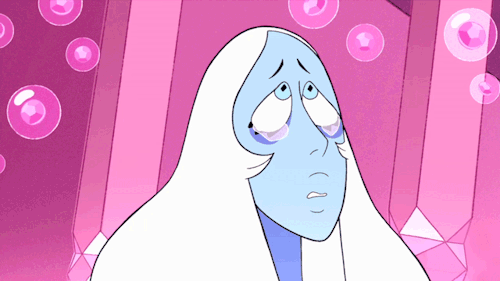
CAN YOU NOT FEEL THEIR PAIN?!
Wanna know why I didn’t compare the Diamonds to Avatar’s Fire Nation when talking about humanizing the enemy and the connection couldn’t be more obvious? Because before Ozai is ever mentioned, The Last Airbender states very clearly that the Fire Nation is the region Aang and his friends need to infiltrate to stop their manifest destiny. And when we’re early hinted that Zuko’s not full on evil, it lets the audience know that not everyone is on board with those in charge of the Fire Nation invasion, leading up to Ozai's big debut where we see that as the endgame villain, he’s irredeemable and has such a lust for power, that he’s recognizably the main drive everyone has to stop. Avatar did this right because little by little, the main enemy was narrowed down to a single force that hasn’t made itself known until near the end when his presence bear more importance. The same can’t be said for Steven Universe because Rebecca Sugar Rush presented yet another faint mistake.
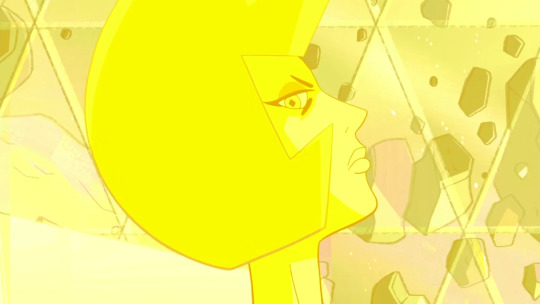
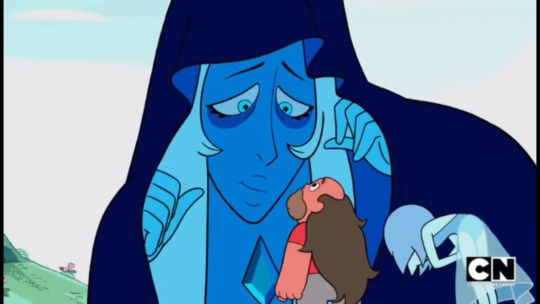
The Diamond’s personalities are given to us before they’ve shown us who they are and what they’re capable of...
So we see Yellow Diamond as a vindictive, no nonsense leader that wants shit to get done and Blue Diamond as a more tender looking, yet no nonsense leader that’s grieving over Pink Diamond’s death and does whatever she can to move on and remember the fallen fondly. So, have they done anything before we’ve met them personally? Sure.
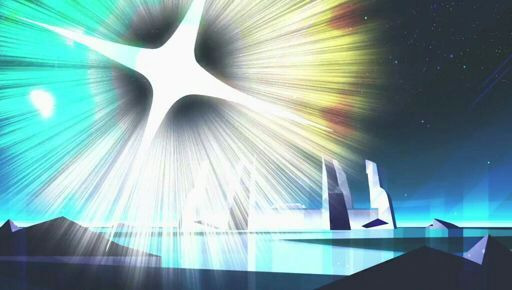
*They corrupted thousands of their own kind (because of the rebellion)
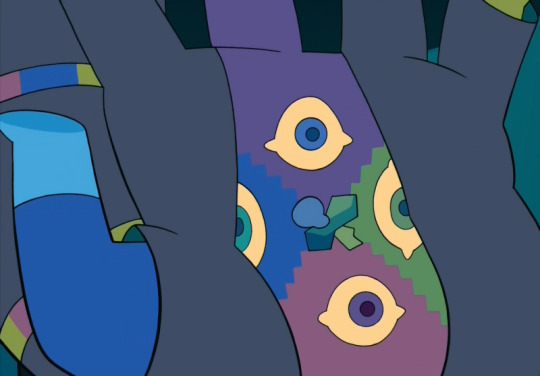
*Allowed experimentation towards shattered gems to make artificial fusion (because of the rebellion)

*Ordered a search and destroy on all “defective” gems that go against the Authority’s standards and prevalence while said defectives put themselves in a literally hole of despair for coming out wrong (Gaslighting)
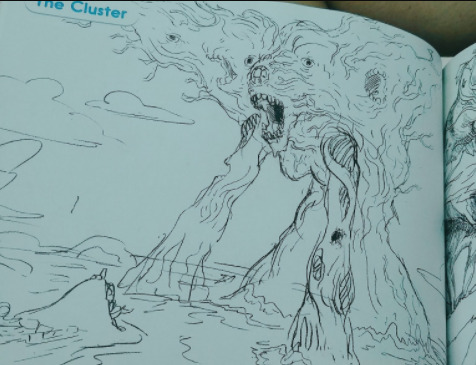
*And let’s not forget the Cluster (because of the rebellion)
So yeah, quite a lot actually. Now you might be thinking, “But Monkey Network, what does those five old men have to do with what the Diamonds did?” Well, when you see the villainous shit the Gorosei have commanded, their actions are actually more relatable.
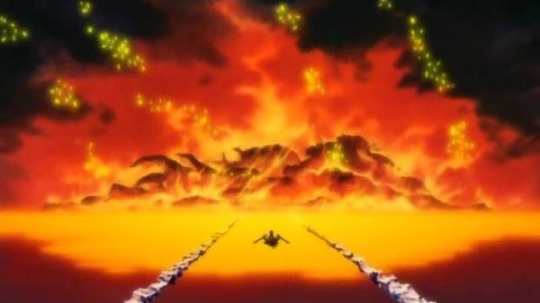
*Ordering the destruction of an island of archaeologists because they were secretly researching forbidden history
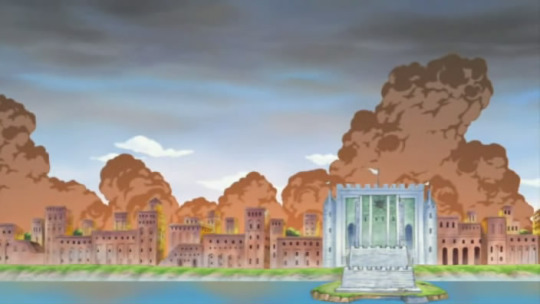
*Allowing a hit on their own government affiliated island to erase any potential surviving threats that invaded there
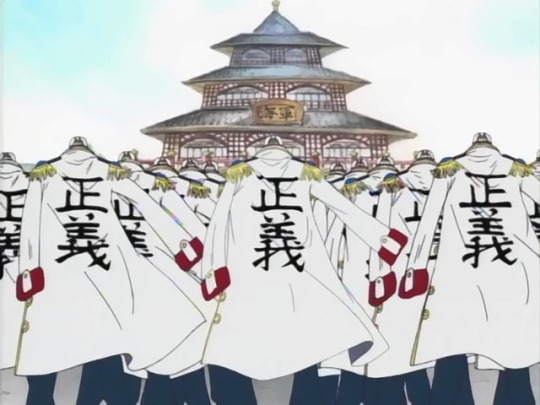
*Directing the Marines, or the front line enemies of our Pirate heroes
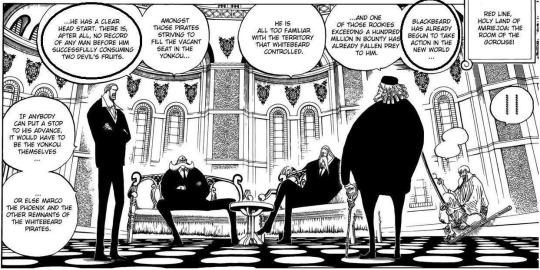
*And contemplating their system’s next move when updates arrive
Now I don’t know about you, but these gentlemen make up quite an authoritative class with understandable motives and relatable notions on running the world without necessarily being on the front lines. Kinda like the US over the years? Even when their level of corruption can be on par and we still know little of their true power and who they really are, they’re instantly better than the Diamond Authority because we can see why they’re in command, their thoughts and actions towards our heroes shows no sign of being sympathetic, and yet we see where their motives lie. I mean, their Government’s enemies are pirates. You know, Pirates? People who’ve robbed and killed and are the opposite of order? See where I’m going here? They namely go after our heroes who are seen to be the enemy even when the Pirates and plenty others consider them the enemy. It’s almost as if there’s a grey choice for the audience to wonder whom the real bad guys are. OooooOOh.
Also, quick side note. The Gorosei look fucking cool. Like their designs aren’t exactly human, credit towards Eiichiro Oda and his expressive designs, but they’re drawn with such a level of seriousness and stature that it presents their elder wisdom and grave subtlety towards a subject in a contrasting light to the pirates bombastic, emotional appeal. But the Diamonds?
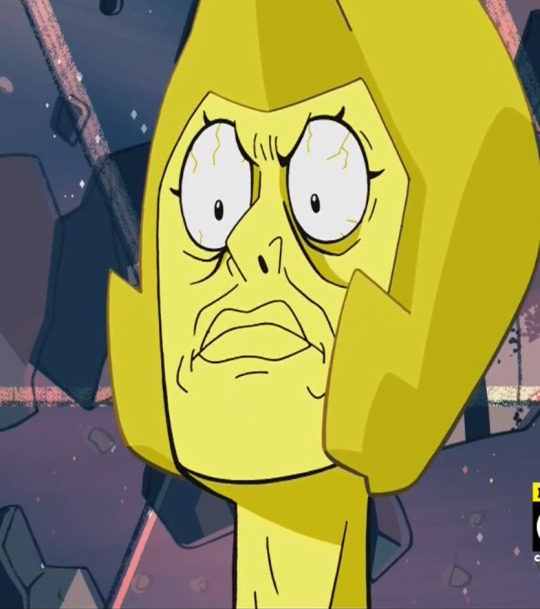
This picture summarizes how I will never take them seriously, no matter how hard they try or how good Patti LuPone is
So, what has this amounted to? Basically, Rebecca Sugardop has given us nonthreatening villains that showed no sign of any redeemable qualities beyond their ability to mesmerize us with their acting. That and give us an episode that, in summary, tells the audience that killing an enemy like the Diamonds makes you no better than them. Yeah, I have to go there.
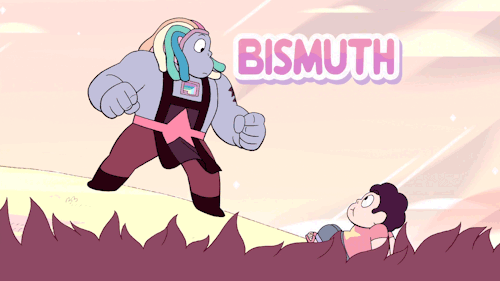
I’ll try and make this quick.
This episode was Crime and Punishment done bad. For Crime and Punishment, it was an old Russian tale of a man killing a woman that’s rich yet unliked in the community because he believed it was for a greater good; implying that murder is permissible in pursuit of a higher purpose. Same can apply to Bismuth, having faith that in killing the Diamonds, Homeworld can be liberated from the oppressive elite. Here’s where that tie-in ends: the effect. In Crime and Punishment, the killer shows sincere regret towards his actions because it didn’t present any change in the community beyond the fact that an old woman got murdered and the only thing the she was despised for was being a greedy pawnbroker. What regret would’ve there been in using the Breaking Point on the Diamonds? Bismuth wasn’t set on killing any Homeworld gem around, just the leader who show that they mean and will mean business unless they’re fully out of commission. The show wanted to say killing the Diamonds is bad even when the effect of it could be good, but never offered any other method to success and just shunned Bismuth to dormancy until they need her again, proving she might have been onto something.
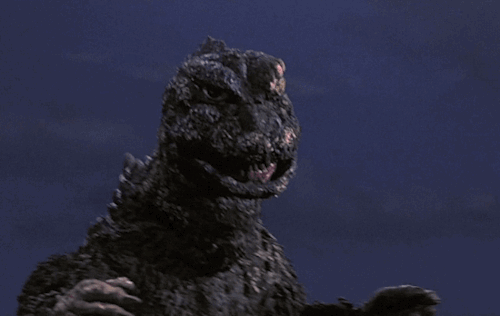
Whew. So, what’s the tl;dr aspect of this since you probably won’t take this seriously. Well, call this a domino effect. Rebecca Sugar Pop is trying to make sympathetic dictators, which is itself an oxymoronic detail. In doing so, she failed to make them real villains. In doing that, there really are no real villains in the show. And when there are no villains, the conflict feels dry and absent. And without conflict, she failed at putting together HALF an overall story. And when you’re a coming of age story where it has to end on some note with maturity and change, after almost five years in the making, you just FUCKED yourself over when you didn’t even invest time in HALF of what makes an overall story of good and evil investing and engaging. Oh I’m sorry, what makes an overall story of a blurred line between good and evil. Investing and engaging.
I can’t care anymore. If they get redeemed, sure. If they end up dying like a tragedy, fine. They feel less like villains to overcome and more like stairs Steven has to step on to become a better person. Just let White Diamond be as grandiose and badass as Tumblr’s AUs of her, because again...
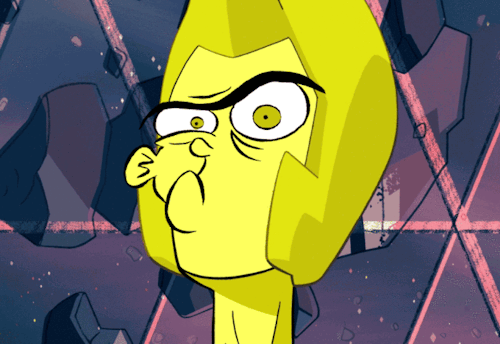
The fandom is doing the show a bit of justice
#steven universe#su#su critical#su criticism#su critique#villains#Bismuth#One Piece#Gorosei#anime#cartoons#reviews#su gifs#analysis#Good Stuff#Roy Macintosh#ye#awesome
309 notes
·
View notes
Text
A Weekend of Emotions — A Review of Puella Magi Madoka Magica Rebellion ft. Philosophic Discussion
Last weekend, I hung out with my big brother and my best friends. This was always normal, we’d game, get drunk, eat good food, etc. However, something happened last weekend that I didn’t expect. A lot of emotions were expressed. Like A LOT... And I wanna talk about that and more in my Brain Vomit review for Puella Magi Madoka Magica Movie: Rebellion. Let me explain...
As you guys can PROBABLY tell by now, Puella Magi Madoka Magica Rebellion is my favorite anime movie. But, I’ll say it now, Rebellion is my favorite movie of all time. I believe it is the perfect film for me. Even with its flaws. Even with its pacing issues. Even knowing how controversial it is. In fact, that’s probably 60% of the reason I think the ending works so well. And while this isn’t a play by play of the movie and everything I liked...
What I want to talk about are emotions, philosophy and how Rebellion — and Madoka as a whole — tackles different responses based on one’s philosophical views. First, context: When “mah bois” and I were wrapping up the Madoka Series, we were going through Rebellion (I was the only one out of us who saw Rebellion and had a blast trying to deflect theories on the twists and turns) but then something caught me really off guard. And it was something I hadn’t expected...
SPOILERS AHEAD FOR THE ENTIRE PUELLA MAGI MADOKA MAGICA SERIES!
youtube
At around the 2/3 of the way through, Homura realizes that the Magical Girls are all trapped in a false representation of their town, Mitakihara City. A good portion of the film is just figuring out what the fuck is going on. And it is a very compelling mystery. Revealing that it is a Witch’s Barrier, a distorted world created by a Witch.
(Tangent: I’m currently writing a case study on the Netflix’s Death Note Movie and writing a mystery. I recommend reading that when I finish it, as well to see these ideas come back in the forefront.)
The strength of the mystery comes down to the series’ ending. As in the series’ ending, titular character Madoka Kaname wished for a world where Witches — the antagonists and unfortunately the final stage of a Magical Girl’s life — could not exist. In this action she becomes a concept known as the Law of Cycles — where as a Magical Girl falls into despair, instead of becoming a Witch, The Magical Girl will be taken to Magical Girl Heaven. But in this wish and action, Madoka’s existence is erased, becoming a concept -- a God.
All except Time Turning Magical Girl Homura Akemi (and Madoka’s little brother for some reason) have forgotten about her... In Rebellion -- which takes place shortly after the series’ epilogue -- Homura realizes that the false Mitakihara City is the work of a Witch and realizes that the only person who could become a Witch because she knew about them as well as Madoka’s existence was Homura herself. In a powerful scene where her false Mitakihara City collapses, she pulls out a pistol and shoots her Soul Gem, realizing that she is the Witch —
youtube
— And while that scene still shakes me, and we watched it in English and honestly, some of Cristina Vee’s best work (just sayin’).
In that moment, I look to my brother to see his response and for the first time in my life, I saw him cry. In fact, my best friend was also caught off guard by his reaction. We wondered if he was OK — I even brought over tissues from the bathroom. We thought something was wrong, but in reality, he was emotionally broken by the scene. The fact that Homura’s effort was for not and the crushing weight of that moment was powerful for him. And that’s when it really hit me just how powerful a philosophy can really bring out certain emotions. The feeling of failure, the pointlessness of effort was something real for him. And yet, from my perspective, it was something I couldn’t relate to.
In all honesty, I’ve never been disparaged by the idea of pointlessness in one’s actions — but I tend to be more of an Absurdist philosophically.
This is where the real meat begins...
In layman terms, the idea of Absurdism — a derivative of Existentialism — and states that the universe is SO illogical, that trying to find meaning and logic in it is a fruitless endeavor. The idea is that it is better to accept the absurdity of existence and find personal happiness in spite of it. embracing what life has to offer is the core theme of Absurdist theory. Similar to Existentialism, the idea is of taking one’s freedom in the universe to make something out of it.
While Existentialism focuses on creating one’s own personal meaning, Absurdism focuses on rebelling against the universe — taking Existentialism to an extreme where personal freedom and agency trumps the search for any meaning. Living life for the sake of living life and enjoying it to the fullest, even if no meaning needs to be conjured. It can be compared to Anti-Nihilism, but they share many key differences. I won’t get into that now though. And yes, to an outsider looking in sounds depressing, but if anything the closest thing I could compare it to is a controlled hedonism — awareness of personal agency. To me personally, it gave me back my personal agency when I believed I had none. Absurdism, philosophically, is the innate reaction to the enlightenment of the universal absurdity of life. Noted by Absurdist and Existential philosophers Albert Camus and Søren Kierkegaard. Absurdity being the fact that the universe works on a logic outside of human comprehension and is thus illogical — hence the term “Absurd”. Enlightenment of this existential crisis in Absurdism leads to three possible theorized actions for humanity:
Committing Suicide — Which is in itself absurd and pointlessly ironic. Extremely deterred by Absurdist philosophy. Turning to God — also defined as the “Leap of Faith”, by Kierkegaard. Which can work and Kierkegaard agrued leads to authentic human life. But to Camus, it is attributed to resolving one’s own philosophical agency or “philosophical suicide”. Acceptance of Absurdity — Which is what Absurdist Camus states is the best action. As you both retain agency and a desire to do as you need to to be happy, dealing with the strive of life without wallowing in despair. The key idea is finding happiness in an imperfect, illogical universe.
(I recommend reading the Myth of Sisyphus, written by Albert Camus — which is one of the first insights and expressions of Absurdist theory.) A good way to think about philosophy in Madoka is like this: Kyubey asks you to make a contract, and this is hypothetically that you understand WHAT being a magical girl meant, what would you choose based on philosophical viewpoints?
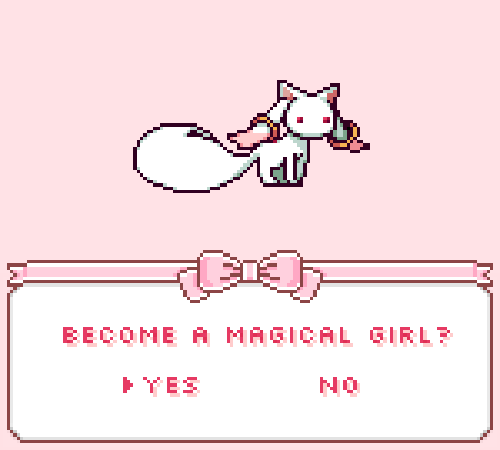
For example: Rationalism: “No. Being a Witch is inevitable and I don’t wanna die like that.” Empiricism: “From what I’ve seen, No. Waiting for the mental scarring to heal!” Atheistic Existentialism: “Maybe. Depends on how I want to be.” Theistic Existentialism: “Learned the lesson from Kyoko Sakura, enough said.” Absurdism: “Why not? You only live once, right? Better think of a good wish.” Nihilism: “What’s it matter? Find someone who cares about universal entropy.” Anti-Nihilism: “It’s better than wallowing, right. Do it!” Skepticism: “How do I even know all you’ve said and what I’ve seen is even true? Isn’t this an anime? If it’s not, prove it. Then I’ll make a choice.” Macchivelianism: “If that means the universe can continue, my sacrifice is worth it, I suppose.” Or “Who would be crazy enough to do it, and how can I get them to do it to further my gain?” That’s a wide array of answers, but it kind of depends on the person when asked realistically. But I hope that this is a good insight to the line of thinking I want to approach Rebellion with.
And now I want to talk about the Madoka series and its writing thematically, as well as the Philosophies and the relationship they share.
Madoka is a story that is fueled by Nihilism in it’s nature. Gen Urobuchi is a nihilistic writer, even if as a person he may be joyful. One’s philosophy does not always equate to one’s emotions on the outward glance. Nihilism is the philosophy that everything is hopeless. There is nothing to be found in yearning for meaning, so it’s better to do nothing but succumb to the despair and wallow. And yet, Puella Magi Madoka Magica ends with a hopeful message, with Madoka becoming a benevolent god. I found it interesting that the series decided to end it’s 12 episode run with that message. But then again, it could be taken another way. Let’s examine Kyubey — Incubator, as an incubator for the energy created by Witches to return to the universe as a means of preventing entropy and the universe can stay alive.— as a character especially in his action is from a Machiavellianistic perspective. He looks for logical solutions to problems and has only his own end goal in mind, and the consequences are more of a means to justify an end goal more than anything else. Remember his conversation with Madoka, he outright states the needs of the universe outweigh the few teenage girls whose lives are lost. Which in itself is not a “bad” philosophy when taken to a smaller scale, for example as he describes — Livestock. Humans eat them and need them to survive, and by comparison livestock live a better life in captivity than in the wild and thus are able to breed healthier and thrive as well, even if a few die to become food. Technically, it’s a mutual benefit, even if humanity is the one holding the power — a means to an end of survival. That’s Machiavellionism in a nutshell. Of course, it’s more complicated and a lot more corruptible based on context but I need to keep this train rolling... Anyway, back to Madoka... Then there is Rebellion — which title makes a lot of sense when thought about. Many people reacted to Rebellion wondering why the message of hope was so drastically toyed with in Homura’s action — Her Rebellion. However, I find that questioning flawed when the series was NEVER about hope, Kyoko’s death is proof of that. Listen to the conversation Homura and Kyubey have after her death — he gave Kyoko false hope as a means to his end — backing Madoka into a corner to become a Magical Girl. His motives are never hopeful and hope should not be sought after, that’s what I found to be the underlying message of the series. Even if Madoka’s action was just, Homura still failed in her mission — and I saw Rebellion as her having to deal with that. I like to view Homura’s actions in the final act of the film as a turn to Absurdism, rather than Nihilism — If she did, she’d despair and die — and a rejecting Kyubey’s Machiavellianism — He’s her enemy after all. Remember, the basic principle of Absurdism is rebelling against the absurd universe for one’s own happiness. Let’s talk about why Nihilism is often first attributed to Homura and points towards it. Firstly, the familiars: In a scene of Homura kneeling and basking to a stonewall of Goddess Madoka during the revelation of her transformation, her familiars are seen throwing tomatoes whilst chanting “Gott is tot”, which is a concept related to Nihilism uttered by Fredrick Nietzsche which translates to “God is dead” or to better articulate “There is no salvation in God.” The Law of Cycles is a god and a salvation to Magical Girls, but in Homura turning into a witch, the Law of Cycles has failed in its duty as an omniscient and thus salvation is not an absolute. While personally, Kyubey’s a little shit for blocking off Madoka’s omniscience, it did reveal that she is NOT omniscient or all knowing. Often that revelation to man leads one down the path of Nihilism, thrusting the concept of God aside as it is not true and believing in such is illogical. However see this concept both played straight and lampshaded in Kyoko Sakura, a Christian, whom in her death — asks God to give her a happy dream. Even if her outward persona would tell you otherwise, and the tragedy of her history, she still never rejected God — God was still a part of her, but her relationship with the concept was rocky, to say the least. She more so adopts a narcissistic realist’s — yet not Nihilistic — outlook on life for Magical Girls because they are alien, they are territorial and they are dangerous to those unaware. They have immense power, but are not tied down by a singular moral figure or responsiblity besides killing Witches — which is more for survival than a duty to Kyoko. That in itself was a defensive mechanism for her. And in that, while she tried to enlighten Sayaka, it was not something that Sayaka could follow behind due to her pursuit of being a selfless paragon. Sayaka represented the Idealist, who knew not of the unfairness of reality. A hero of justice who was loved for the things she did, was not realistic. Hence, why this I stated her character arc was deconstructive of the Paragon. And just like in her death, all of Kyoko’s attempts were also in vain. Ironically enough, Kyoko and Sayaka represented to halves of Buddhism. The one that knew the truth and desired to enlighten, and the one who upon enlightenment, could not bare it, fell to despair and died. Kyoko, the figurative Bodhisattva — sacrificed herself for the sake of Sayaka, and ultimately died fulfilling nothing. Yet, was at peace with herself — being arguably, the most progressed of the Magical Girls. In Buddhist philosophy, the idea of enlightenment is focusing on the self and fully expanding one’s knowledge of the self to better understand the world. And upon enlightenment, they transcend their mortal desires. Siddhartha Buddha did the same becoming a higher being because of it, thus entering Nirvana. Those who followed suit but decided to stay on earth would be responsible for passing the lessons onto others — these people titled Bodhisattvas. You can see now why Kyoko’s transformation sequence involves a combination of Buddhist and Christian imagery.
With that out of the way, I’d like to summarize the events of the finale to the movie. In the final act after Kyubey’s Isolation Field is destroyed and Homura’s soul gem returned to her. The audience witnesses the Law of Cycles — Madoka Kaname as a concept — come to purify and take Homura to Magical Girl Heaven. But in a twisted move, Homura splits Madoka’s God-like Entity back into the physical exist of Madoka Kaname (it makes a bit more sense in context) and becomes a Demon, restructuring the universe and becoming the concept of “Evil” through her love for Madoka. And although she creates a rather negative world from a viewer’s standpoint, it is closer to human concepts of reality, religion and Dualism — In fact, it’s more ideal to what the girls had been fighting since the beginning. Quickly defining Dualism: It is a concept that two pieces in nature exist, a yin and a yang. Both are in constant battle for victory, but often they are more of a check and balance, thus working in harmony with the universe. This concept can be observed in the final moments of the film, Madoka attempts to awaken her God-like power and Homura stopping her — bringing back balance, where Madoka cannot gain control over the universe and erase her existence. This can be seen as one of two things: 1.) Homura (The Devil) is keeping Madoka (God) away from helping people and re-rewriting the universe again. 2.) Homura is creating a balance for this new world. It is a happy one, where the only tortured soul is Homura herself and she is content with that. Thus nothing needs radical change. Now if Homura actively tried to eliminate Madoka entirely, then this would be a problem. But that is not the case. This second observation is more where I fall in line with to interpret, and that’s where I thought about Homura and Absurdism. In creating a Dualistic System, Homura indeed creates a happy world. Madoka didn’t need to be a Magical Girl, whilst Sayaka, Kyoko, Mami and Nagisa are alive — leading happy lives with their friends and loved ones. I'd like to argue that Homura created her world in spite of the absurd universe that tormented her and Madoka. Her view on this could be influenced by her words with Madoka during the flower field scene, which is often pointed as the birth of Homura’s main crisis throughout the film. But in that, she created a world where they both can exist and in revolting the cruel universe, basically said “Fuck you” to Kyubey’s Machiavellian tactics. It can also be argued as well that she was corrupted by her experience as a Witch inside of her own soul, which I identify as valid. But I prefer interpreting it more in her actions being in spite of the hopelessness she felt. And since there is no one way to interpret the series, as the creators have not said anything on how to interpret it from my knowledge, it is free reign. Like Sisyphus, in being able to create a world where Madoka would be happy, Homura could “push the boulder up the hill” or survive in her personal hell and be satisfied with it. She takes Absurdism to an even further extreme, which realistically should be thought of with more than a grain of salt. But for the sake of this being an anime, I’ll let it slide. And satisfied she appears to be, as seen in her “victory dance” at the end of the movie. Sure, she fell off a cliff (which I can be 100% certain didn’t kill her as she’s been through much worse and it’s more metaphorical to show her fall from God [Madoka] into a new entity), and familiars do represent the true feelings of the Witch, and they are seen committing suicide — that does not matter in Absurdist philosophy, since Homura does not kill herself and finds happiness in saving Madoka’s existence. Even in an absurdist hell, Homura continues to be satisfied and she doesn’t really care what happens to the status quo of Magical Girls and their relationship with her — as seen when she says Sayaka and her may become enemies when the Wraiths are extinct, but so long as Madoka is happy, Homura can live in spite of her personal hell. She has, for all intents and purposes, accepted the absurdity of EVERY universe and performed the ultimate defiance -- her Rebellion. She got what she wanted — Madoka is happy — her wish fulfilled and Kyubey got the just desserts that Homura had wanted to give him for years. This can even be interpreted in that no could understand her reasons for rewriting the universe and her love for Madoka. Though this could also be her being egocentric and her “Love” is definitely more selfish than selfless, but she IS doing it for Madoka. But can it even be defined as “Love”? Sayaka questions if it is more “Obsession” or “Desire”, compare to “Love”.
Thoughts for days... I’d love to hear some more interpretations on the matter.
Ugh, I love this movie! It makes me think!! And with that, I’d like to segue into the conclusion with Kyubey’s words and direct them to reactions to the film as a whole: “Why are [feeling the way you do]? [The movie] has served its purpose and has concluded its existence as necessary.” This very much comes to mind every time I see a new reaction to it.That in itself cannot be answered by just one philosophy or person to collectively represent the whole. It can be answered in as many ways as there are reactions and explanations for the film. And this where I believe Puella Magi Madoka Magica Rebellion is one of the most successful and outright fantastic films of all time. Akiyuki Shinbou and Studio Shaft really outdid themselves with this one. I’ll address the bias that I could be reading too much into it. And yes, Shaft is known for ridiculous amounts of metaphorical imagery and often are chastised as “pretentiously artsy” or “throwing symbols around without meaning” but there are TOO many incidences in Rebellion for that to be “Just coincidence” in my eyes. Gen Urobuchi did say in interviews that the ending to Rebellion would be divisive: From the community’s general hatred of the ending and Nihilism. To my satisfaction with it due to the nature of Absurdism. To my brother’s tragic feelings with it due to the nature of his relationship with God. To my best friend’s questioning of the pragmatism of the ending in being a Logical Skeptic. To my boyfriend’s sympathy towards Kyubey’s desire to preserve the world, even if his methods could be seen as inhumane. And even my sister, who couldn’t finish it and became Existentially depressive. This has certainly held true.
In the end, philosophy is not black and white, nor good or bad. It is more of a way that one articulates the world around them. Whether seeing it as an optimist, a pessimist, or somewhere in-between — to order or to chaos. Philosophy should be thought of with different strokes and philosophical arguments, debates and revelations are always changing with the modern world. I think Rebellion, and Madoka Magica as a whole works as a philosophical piece. A dive into how philosophy in art can be articulated and represented, but also in all the reactions, reasonings and people who have come to interact with it. To finally wrap up this LONG essay, I’ll restate that Puella Magi Madoka Magica Rebellion is my favorite film of all time. I hold the series itself in similar high regards — but I think the series is far less thought provoking compared to the movie (except for Sayaka character arc and Kyoko). (Before you ask: My favorite anime of all time is The Slayers. I love it for more nostalgic reasons than it making me existential. Sometimes, dumb campy fun is just as necessary are thought-provoking introspection and artistic expression.) But in Puellla Magi Madoka Magica Rebellion’s case: I believe a perfect movie doesn’t need a score of 100% on Metacritic. I believe a perfect film needs to be so provocative and thought-provoking that I never get tired of watching it. Rebellion is that movie to me. Flaws and all. Pacing issues of the first act and all. Even in this still rampant dub vs subs debate in anime communities — I don’t care enough to weight in, I watched it dubbed and subbed, both were of good quality. The dub may have lacked the moe-inspired voices, but at the same time, I hate moe — so them speaking in english was fine by me. Neither one takes away from this wonderful experience. I could compare it to the ideas brought about in Bojack Horseman — My favorite TV show of all time. But taken to an absolute absurd level that requires viewing.
I recommend giving the series multiple watches and come up with your own opinions and ideas. Share your reactions and really learn something about other people by how they react to the series as a whole. You can find the entire series and all the movies for Madoka Magica on Netflix.
I’d like to say if you have any other series you’d like me to cover or analyze, send me a question to my Ask box! Or if you want to support me, check out my other case studies and analyses and follow me! I hope you all enjoyed my rambling and have yourselves a fantastic rest of the day. I’ve been Tuchi, This is my Brain Vomit, And I hope you always bloom proudly!
youtube
-- TUCHI OUT!!
References:
Aronson, Ronald, "Albert Camus", The Stanford Encyclopedia of Philosophy (Summer 2017 Edition), Edward N. Zalta (ed.), URL = <https://plato.stanford.edu/archives/sum2017/entries/camus/>. Simpson, David, “Albert Camus (1913-1960)” The Internet Encyclopedia of Philosophy, URL = <http://www.iep.utm.edu/camus/>. Crowell, Steven, "Existentialism", The Stanford Encyclopedia of Philosophy (Spring 2016 Edition), Edward N. Zalta (ed.), URL = <https://plato.stanford.edu/archives/spr2016/entries/existentialism/>. Markie, Peter, "Rationalism vs. Empiricism", The Stanford Encyclopedia of Philosophy (Fall 2017 Edition), Edward N. Zalta (ed.), URL = <https://plato.stanford.edu/archives/fall2017/entries/rationalism-empiricism/>. Nederman, Cary, "Niccolò Machiavelli", The Stanford Encyclopedia of Philosophy (Winter 2014 Edition), Edward N. Zalta (ed.), URL = <https://plato.stanford.edu/archives/win2014/entries/machiavelli/>.
#puella magi madoka magica#rebellion#review#case study#brain vomit#philosophy#absurdism#nihilism#existentialism#reactions#exploration#anime#analysis#over analyzing#new series#hobby#madoka kamane#homura akemi#sayaka miki#sakura kyouko#mami tomoe
5 notes
·
View notes
Text
Wednesday Roundup
The late but always reliable reviewer Rena is here today. I sat on this one for a while considering the... internet-wide discussion we all are a part of now given Marvel’s recent revelations from this particular Wednesday, and the fact that I have a Marvel comic (even if only one) on my Roundups today made me somewhat reluctant to fully get into this, but I had, personally, a good Comic Day and I would hate to waste the opportunity to share the good in comics going on right now with all of you. So we’ll see how everything stacks up, and just how I’ll be handling Roundups in the future as a result of the current... nastiness, we’ll call it.

DC’s Batwoman, Image’s Descender, Marvel’s Invincible Iron Man, DC’s Super Sons, DC’s Superman, DC’s Superwoman, DC’s Trinity
DC’s Batwoman (2017- ) #2 Marguerite Bennet, James Tynion IV, Steve Epting, Jeromy Cox

As worried as I was with the Batwoman: Rebirth issue -- and I think I laid out my concerns pretty fairly, I have to fully admit that my worries have been almost entirely subsided as we go forward starting with this issue.
I always have this concern when there’s a continued revisionist history of a character’s origins that we’re going to be falling into a Donna Troy affect -- where every author is more interested in retelling and retconning her history than actually allowing the character to be who she is and moving forward from there. A problem in comics that disproportionally affects female characters if you’re sharp enough to notice such things.
This issue really helped me to put down that worry mostly because while, yes, we are revisiting Kate’s past for the hundredth time in the last ten years, the story proper is actually pushing us and her forward rather readily while not shying away from the aspects of Kate that make her Kate.
Her loyalty, her issues with commitment, her homosexuality -- everything comes into play this issue and leaves us itching for more involving these Many Arms of Death plot overall. I’m very excited about this comic and am so glad that Maguerite Bennet is becoming such a good fit for it.
Image’s Descender (2015- ) #21 Jeff Lemire, Dustin Nguyen
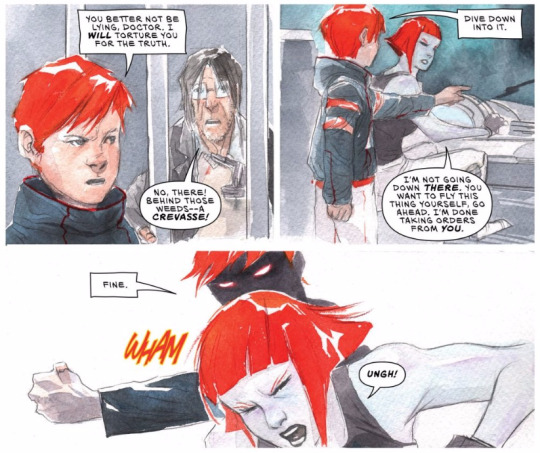
So I just recently got caught up on Descender in time to review the newest issue the week it came out, so I have to give major thanks to @feministbatman for recommending this comic to me. What can I say, you know me so very well and my love for robots and sci-fi has been incredibly rewarded for it.
This issue was another brilliant one, we had Tim-22′s reveal and takeover of the ship, but we also got to see a lot more development of Andy and Effy thanks to Bandit’s little vision quest of sorts for us.
But of course the most anticipated and worrisome part of all of this is worrying for Tim-21 who is still in Psius’ hands and at the heart of the Havester plot that keeps on thickening.
It’s hard to say much else.
I will say that while I’ll always be a fan of Nguyen’s signature style, I do find at times the choice to make this entire comic watercolor rather than more inked and refined does do some disservice to certain moments I think could benefit from having stronger color and more definition to them, but that’s a general criticism I’ll probably dive more into with the wrap up of this arc.
Marvel’s Invincible Iron Man (2016- ) #6 Brian Michael Bendis, Stefano Caselli, Marte Garcia
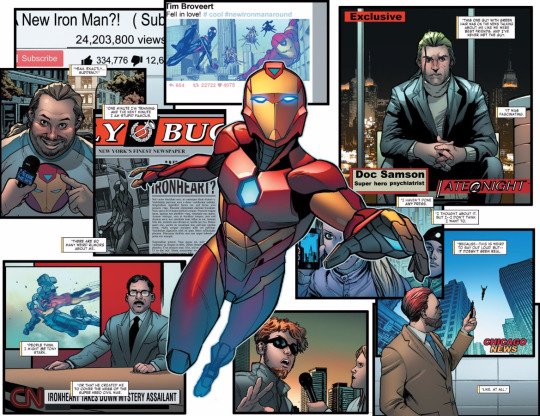
An entirely all-female supporting cast to a female Black superheroine Ironheart with our token dude (Tony) being a computer AI. It’s the setup dreams are made of and I love how much love Riri is getting in the media and the world for her choices here.
It’s also incredibly relatable how she reacts to being in her idol’s workshop, the idea of her “using it as her base” is unfathomable and her geeky cries of “THIS IS HOLY GROUND” had me literally laughing out loud. I loved it, and I loved how much agency and voice is given to Pepper as Rescue. So often when a young new hero takes over an identity, the trailblazers before them get left out (looking at you Captain Marvel, though you did make up with it in a pretty good issue yourself).
There’s just so much to love in this comic and I’m glad that at the end of the day, even with all the Women in Science, it doesn’t diminish Riri’s single mom who works a 9-5. That relationship, you can already tell, is going to be monumental moving forward.
Great issue, great introduction to Riri. Am looking forward to seeing more of her.
DC’s Super Sons (2017- ) #3 Peter J. Tomasi, Jorge Jimenez, Alejandro Sanchez

To put things simply: This book might be one of the most amazing things that DC is putting out right now and if you have absolutely any interest in it at all, I would highly, HIGHLY recommend you pick it up because this is some a-grade fun. I adore having this book to look forward to and the antagonism as it comically plays out between Damian and Jon is easily some of the best stuff I’ve read with Damian’s character since the Robin: Son of Batman comic.
Which, if you know how much I flatly adored that comic, should obviously be taken as pretty high praise.
That being said, there’s some issues. Damian’s skin tone is not being protected enough by the editors and the whitewashing, especially compared to how good DC’s Rebirth comics have been about it in other series, is very distracting and supremely disappointing.
Jon has grown on me very quickly and while I will continue to talk about my longing for Chris Kent and my apprehensions about the continued theme of biological kids erasing the bonds of adopted kids, this is a good comic overall.
DC’s Superman (2016- ) #21 Peter J. Tomasi, Patrick Gleason, Mick Gray, John Kalisz
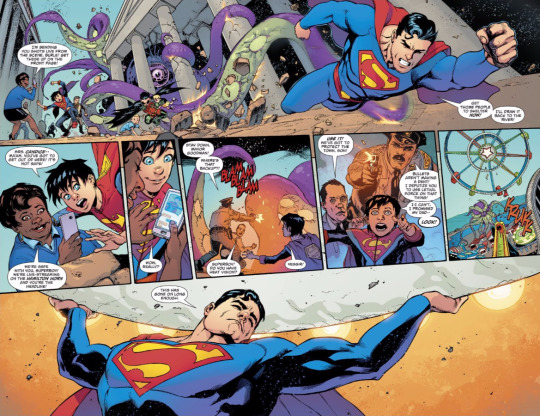
In this episode of “how is an evil cow taking down Batman” today, we get no such answers to no such questions, but we get a giant octopus monster fight with Superman, Superboy, and Robin and -- really -- isn’t that the content anyone really comes for in a Superman comic.
Once again, Jon’s heat vision is out of control and kills something, but rather than it being another moment of horror and reflection for him, as his father was trying desperately to save the creature’s life along with the citizenry of Hamilton, but the entire town seems to turn on Superman and praise Jon over him for “doing what is necessary.”
Now, this might be me reading too much into this (and read: it is) but this seems honestly like a huge commentary on the values of classic heroes like Superman being put in stark contrast to the blood thirsty and fear mongering of the public today. Too often we praise the most immediate and final of reactions rather than the harder and grayer solutions which Superman is supposed to be able to give us.
And considering how awkward the praise heaped on Jon feels in this issue, and the surprise revelation at the end, I’m pretty sure we’re not supposed to like that a life lost unnecessarily is being celebrated by everyone around.
Damian and Jon are still a ruckus and everything is still very intriguing. This is definitely my favorite Superman run in a long time.
DC’s Superwoman (2016- ) #9 K. Perkins, Stephen Segovia, Art Thibert, HI-FI

So here we are starting off with a new creative team and resetting my Rule of Three, which for anyone new means that I give new runs and new comics 3 issues to hook me before deciding how to handle the series moving forward. And considering that I wasn’t exactly thrilled with the last two or so issues of Jimenez’s run, I’m not completely objecting to a bit of a change up in the creative team.
This issue is dealing with the fallout of the Superman Reborn storyline and mostly about Lana dealing with once more being powerless, and how that makes her feel conflicted. I felt like this dealt with Lana’s emotions in a much more respectful and loving way that the last issue did, definitely, but mostly the issue read as filler before we get into the next arc which’ll be starting with #10.
So here we go into curiosity. I’m very interested in where this new team is deciding to take us.
DC’s Trinity (2016- ) #8 Cullen Bunn, Emanuela Lupacchino, Ray McCarthy, HI-FI

Another issue, another tie-in, another creative team change. Now, I’m going to be flat honest with you: I have absolutely no explanation for what happened in this issue. And I’m not doing that for comedic effect, it’s just honest.
This definitely felt like more filler before we get to somewhere beyond all the crossover events and can instead return to Trinity���s desperate attempt to find its own status quo. Something that positively worries me because its predecessors in spirit, Superman/Batman and Batman/Superman, never really cohesively found that groove for themselves.
For the time being this feels like after the first arc, this series has become something of a place for reactionary storytelling -- basically paid advertisements for bigger events going on in the rest of the DCU.
I desperately hope I’m wrong, I really liked the first arc and would like to see more friendship-centered adventures between DC’s Big Three, but I’m going to officially move this series to trade-wait if things don’t change by the next issue. We’ll see.
So this has been a rough week for comic fans, there’s no getting beyond that, and this Roundup was at least in part held back due to my own concerns about just how much the fallout of some truly bad decisions over at Marvel was going to play into my own feelings toward comics this week.
I feel, overall though, I had a good pull this week, and while some were a little lackluster and have gained my reservations, I overall really loved my Super Week. And of my Super Week I definitely have to give my favorite issue to Super Sons, which has just turned out to be a spectacular gem to follow and I’m very glad for it existing.
But how do you all feel about this week? Any comics I missed you think I should try out? Any disagreements with me on this week’s picks? I’d love to hear from you!
#Rena Roundups#Wednesday Spoilers#SPOILERS#Batwoman (2017 )#Descender (2015 )#Invincible Iron Man (2017 )#Super Sons (2017 )#Superman (2016 )#Superwoman (2016 )#Trinity (2016 )
3 notes
·
View notes
Text
Call My Agent!—They’ll always have Paris, because they f*cking live there
youtube
Searching for six hours—well, more like 315 minutes—of Trump-free consciousness? Then, if you haven’t already, sign up for Netflix and check out Dix Pour Cent, aka 10 Percent, aka Call My Agent! (which is what Netflix calls it), a catch as catch can tale of agents, actors, directors, wives, mistresses, boyfriends, sons, daughters, and other hangers on in the City of Light, all revolving around that most important, or at least most self-important, of all worlds, le cinéma.
I wish I could write an intelligent review of Call My Agent!, but, well, I can’t. Usually when I write my reviews I cheat a little (or a lot) by relying on Wikipedia or somebody so I can identify all the characters, and the actors who play them, and not make any glaring errors in my plot summaries, etc., but in this case I can’t because, sadly, Call My Agent! doesn’t seem to be that much of a thing—only one season (of two) is available in the U.S.—so I’m pretty much a trail-blazer here and I won’t be providing much more than a once over easy on this one. I’m particularly at a loss because the series features numerous cameos from famous French film folk, about whom I unfortunately know nothing.
We begin with a crisis, of course. In la vie de Bohème life without a crisis is no life at all, but rather death. Agent Gabriel Sarda (Grégory Montel) is struggling with a tempestuous diva, Cécile, who is struggling to learn how to ride a horse, which she had earlier, and falsely, claimed she knew how to do. But her burden is small compared to Gabriel’s, because he’s learned that the deal of a lifetime—of several, in fact—a trilogy with Quentin Tarantino—oui, that Quentin Tarantino!—has fallen through because Quentin thinks Cécile’s too old. Too old! Jesus! Why not just kill her? It would be so much more humane!
But for the moment there’s a more immediate crisis, one that, fortunately, is a lot more manageable. Cécile isn’t supposed to be out riding a horse. She’s supposed to be in Paris for some sort of photo shoot at some impossibly stunning salon that, unless you’re Louis Quatorze, you can’t possibly afford. Gabriel brings her in, still reeking of the stable, but, never mind, Cécile may not be able to ride a thoroughbred, but she is one. A quick wardrobe change and she makes the room look shabby. Mission accomplished! Well, the easy part.
Gabriel knows all too well that discretion is the better part of valor, by far, so he leaves the bad news for later. He has to get back to the agency, ASK, aka Samuel Kerr Agency, because Samuel Kerr, the founding father and beloved papa, is going on vacation, for the first time in his life! Gabriel makes it back just in time, giving us a glimpse of the rest of the cast, including Papa Samuel (Alain Rimoux), the Yves Montand-ish Mathias Barneville (Thibault de Montalembert), a cute gay guy, a couple of seen it all French broads (okay, they’re all French, but these are like French French—old French), and Andréa Martel (Camille Cottin), who, it will emerge, is a bit of a diva on her own.
While the farewell party is going on, a sweet jeune fille wanders in. “Just give me your resume,” Sofia, the stunning biracial receptionist (Stéfi Celma), tells her briskly (in French, of course). “We’ll get back to you.” But shy Camille (Fanny Sidney) isn’t an actress. She just wants to see M. Barneville, and, no, she doesn’t have an appointment. “He’s very busy,” Sofia tells her. But when summoned Mathias appears with surprising quickness. Do we have a plot? I think we do!
Mathias is not at all happy to see Camille, suggesting that she is either his mistress or his bastard, and his nervous line of questioning strongly suggests the latter. Camille is newly arrived in Paris, from that region of France that is, basically, not Paris. She clearly likes the place and isn’t planning on leaving, even though she has not a euro, and even though Mathias clearly isn’t planning on giving her one.
While Mathias is struggling to get rid of his bastard daughter, Andréa is getting all boss from Hell on her helpless assistant, who can’t keep track of all the people she’s lying to on Andréa’s behalf, or even remember which lies she told whom. Plus, there’s Andréa’s love life. She’s into chicks, but there’s a lot of turnover, and it’s hard to remember who she’s avoiding and who she’s screwing, in part because Andréa can’t always remember herself. The assistant, acting out every assistant’s dreams, tells Andréa to take a taxi to enfer. She storms out of Andréa’s office, out into the reception area, where waif Camille is still wandering about in confusion.
“All right then, go to Hell!” shouts Andréa (more or less). “You! Are you looking for a job?”
The answer to that question is not no, and so off we go into the wonderful world of dix pour cent. “We have no lives,” Andréa explains. Their clients are their lives. They live in shitty apartments, they have no money, no husbands, no children, no nothing! But what do they have? They have art! They are the unseen, unheralded, yet all-important grease without whom the adamantine wheels of artistic ego would shatter one another to pieces and bring the sacred world of cinema to a splintering halt.
Yes, the life of an agent is always Hell, but it’s about to get a lot tougher for the folks at ASK, because scarcely has Papa Sam reached his vacation destination—the sunny beaches of Brazil—than the word comes back that he’s dead! Dead? How is this even possible, demands Mathias from the officious official informing them of Samuel’s decease. “He ate a wasp,” the official explains—that being, apparently, the sort of answer you get from the French government when something bad happens.1
Sam’s death is a particular stunner because he was, clearly, the only grown-up at the agency. Gabriel, Mathias, Andréa, and all the rest blink like kittens suddenly exposed to sunlight. We have to pay our bills now? And our taxes? But Sam always took care of that!
ASK’s problems continue to mount. Sam owned a controlling share of the agency, and he died intestate, so all his shares pass to his widow, Hélène (Gabrielle Forest). She’s a grand old femme, to be sure, but how do we know that the grand old femme won’t sell us all out and retire to the Riviera? Blood is in the water and the sharks are circling. And what about our clients? Those artists don’t give a damn about anyone or anything but themselves!
The uncertainty puts a double strain on the standard uncertainty of the dix pour cent business—the constant caressing, cajoling, and hand-holding of friend and foe alike, deceiving your friends and servicing your foes, running madly to stay in place on a frenzied carousel. But—and here is the kicker—somehow it all works. The lies that seem to lead to disaster lead instead to art! The two deadly enemies you booked for the same film, for the director they both loathe? “I can use that energy,” the director gloats, rubbing his hands together in glee. That impossible director who brings in everything over budget and overdue? His reworking of the memoirs of the duc de Saint-Simon is a smash!2
Yes, the madeleines here are a bit too sweet, too candy-coated—too many grand receptions, shoots, and gatherings in impossibly elegant surroundings, too many pretty girls waiting on “you” hand and foot, so much 18th-century privilege handed out to our 21st-century strivers/survivors.3 Even Andréa’s apartment, which was supposed to be a mess, is a little gem. People in Paris have killed for less—for far less—I’m sure.
As the first season ends, the gang at ASK, having survived everything, even a government audit, gather to drink Sam’s private stock of whiskey to celebrate a coup that’s going to assure that the agency will remain independent. Alas, the coup doesn’t quite come off, but so what? They aren’t dead yet, and there’s nothing wrong with getting drunk on the boss’s whiskey. Besides, as one of the old broads puts it, “Whenever I get depressed I go to a movie and that cheers me up.”
Okay, way too on the nose, but I enjoyed myself without the boss’s whiskey. Hey, Nextflix! Season deux! Now!
Afterwords Dix Pour Cent, directed by “César winning” director Cédric Klapisch, gives an unconscious representation of the “Paris Provincial” world consciously presented in Julie Delpy’s Two Days in Paris4—an incestuous assembly of self-indulgent enablers whose feckless life is made possible both by the extraordinary artistic treasures of Paris and massive government subsidies (largely funded, in turn, by taxes on Hollywood films), in the illusion that they are adding to those treasures.5 It’s also reminiscent of Hollywood films like Woody Allen’s Café Society and Martin Scorcese’s The Aviator, which simultaneously “expose” and sentimentalize Tinsel Town.
Sam’s cause of death is grounds for a funny running gag as the cast must repeatedly explain to grieving friends from other agencies that, no, Sam did not die in an orgy. But why else would one go to Brazil? A wasp? Are you sure? ↩︎
Many of the “impossible” people here are celebrities playing themselves, which would be a lot funnier if I knew who they were. ↩︎
Le meilleur century for the French was really the 17th—in the 18th they got their asses kicked by the British too often—but the 18th looks more comfortable. ↩︎
Delpy starred in the film, wrote, directed, produced, and edited the film, and also composed the score. Charlie Chaplin, eat your heart out! (Actually, Chaplin matched Delpy, although he sometimes had help with the script and he always had help—a lot of help—with the music.) ↩︎
There is, unsurprisingly, not a hijab in sight, and the few blacks we see are seamlessly integrated into French society. Hey, this show is about escaping your problems, not solving them. ↩︎
3 notes
·
View notes
Text
Dark Souls Lore Ramblings #1
So before I go on, I guess I should make it clear that I haven’t played DS3 or DS2. So, if there’s any information that contradicts or explains something, I probably don’t know about it. I’ve just got what I absorbed through pop cultural osmosis.
I don’t really have any particular order or priority in mind for what I’ve got to say, so this could be kind of all over the place. If you want to know my opinions on something in particular, you should probably drop me a message or a leave a comment or something. With that said, let’s start at the very beginning. I understand that it’s a very good place to start.
Dragons in Dark Souls

So, the Everlasting Dragons. I guess they’re the start of Dark Souls. In the beginning, it was all stone and mist and arch-trees and dragons. Everybody and their mother knows from the interviews with Miyazaki that the dragons are more like elementals than flesh and blood creatures. Their scales are made of stone, the same way the arch-trees are made of stone. So the dragons, the trees, and the earth are essentially all one in the same, to some degree. At the very least, the dragons are part of the landscape and the trees might be their own separate things, what with being the pillars of worlds and all.
Anyway, this is all to get around that whole disparity of existence thing. Rocks don’t die; they’re not alive, but they don’t die, or become undead, or whatever. They still succumb to entropy, but that’s real-world science being applied to a very broadly painted mythic portrait. The way I figure it, the dragons just sat around for millennia, fusing with the ground, coming out of the ground, going back to the ground, all in an endless cycle with no actual beginning or end. Seems appropriate.
Now here’s where things get tricky; did the Everlasting Dragons know about the First Flame and the Lord Souls? Were they trying to keep them down? If they didn’t, then the war against the dragons was perpetuated solely by the Lords; they began a fight with creatures completely beyond their comprehension and perspective. But then, why have a fight? The Lords didn’t even want the place that the dragons had; that would become Ash Lake. The Lords wanted the luxury suite in the arch-tree’s branches. (Whether that refers to exclusively Anor Londo or reality as a whole, I don’t know. We’ll get there when we get there.)
The way I see it, the Dragons did have some agency in this conflict. They didn’t just happen to be there. They were guarding the arch-trees, trying to stop the Lords from establishing reality. They actively opposed the First Flame and the cycle it brought. But why exactly? Well, the obvious, existential answer is that they wanted to avoid the pain and chaos of being. Why go through life and death and all that humdrum when you can be an Everlasting Dragon? Then I thought that it might be to avoid The Dark, or Death, or whatever else; something so horrible that the high point isn’t worth it, that an eternal purgatory is better than having to live with the worst. But then I started noticing details about the dragons;
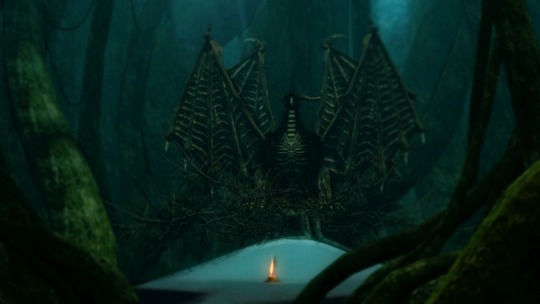
Stone Dragon. Last of the OG Everlasting Dragons. Hatched in secret or hid away somewhere. Possibly also a Bonfire Maiden, but that doesn’t make any sense (or does it?). Offers Nirvana by offering an escape from the cycle of Light and Dark by becoming somebody’s scale-sona. Anyway, count the limbs on this guy and the dragons from the opening cut scene; four legs, four wings. That’s eight limbs in total.

The Gaping Dragon. Coolest dragon in dark fantasy. Succumbs to the pleasures of the flesh and grows a giant ass mouth to feed its gluttony, because Soulsborne runs on that kind of fairy tale logic. Locked up in Blighttown for a long while until its jailers were too weak to contain it or feed it; probably both. Got hungry, escapes, rampage. I like to think it was worshiped as some kind of sewer god for a while, but that’s pure fancy. On topic; four wings, and... well, eight legs. Twelve limbs in total, but I think we can make an exception given the whole freakish mutation thing.
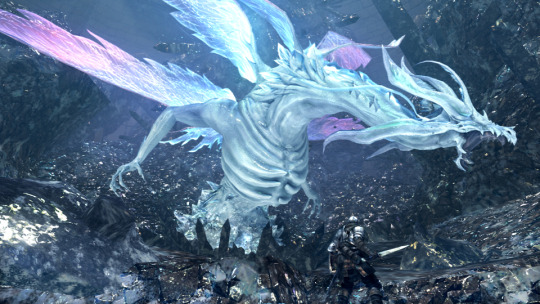
Now Seath? Seath’s another horrible, freakish mutant. He’s got two arms, six wings, and a whole bunch of tentacles/tails. So that’s eight limbs plus whatever’s going on down south. I’ll be honest, I was going to cover Seath as his own separate business later. But Seath is important; Seath is described as being born. Not fissioning out of the stone, but being born. Birth is tied to death, implying that Seat, unlike the Everlasting Dragons, is tied to the cycle of existence. The whole point that I’m making over these last three is that the original Everlasting Dragons come with eight limbs.

Cut to Kalameet. So called by Gough as the ‘last of the great dragons’. Big boy. (That gemstone in his head might be a nifty callback to draconic lore; in both the East and the West, dragons were described as having magical glowing gems that they stored in their head. In the East, these were the pearls that lung used for flight and to control the sea, while in the West, these gems were the dragon’s actual brain, and had fantastic divinatory and alchemical properties.) I imagine he started rampaging around Oolacile after the Dark hit and the Four Knights fell to shit. But count his limbs; two wings, four legs. Six limbs. If Kalameet is the ‘last’ of the great dragons, then that means he is well after the Lords won against the Everlasting Dragons. He may even have been born in the last days of the war proper. But in any case, Kalameet is literally lesser than the Everlasting Dragons.
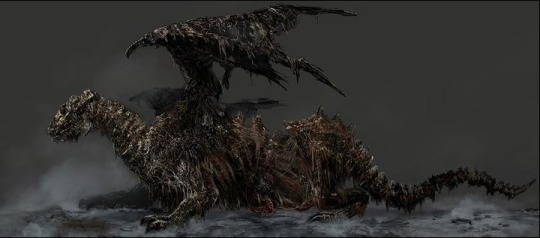
Similarly, we don’t know a lot about the undead dragons, but they follow the same basic rules. Four legs, two wings; less than the Everlasting Dragons. What’s more, they’re actually well and proper dead. I mean as much as anything that’s undead (and not an Undead) is dead. They’re corpses animated by some kind of magic or willpower, that’s all. But the cycle of life and death has absolutely affected them.
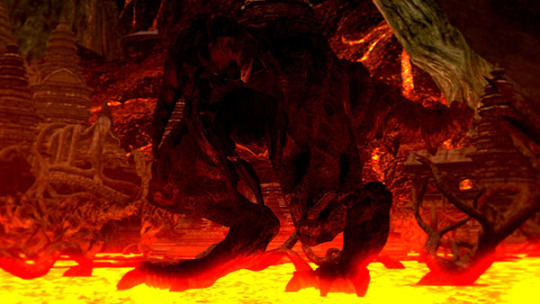
Also, their asses are in Izalith. I have no idea what that’s about. It honestly kind of infuriates me. I feel like I could just put the word “IZALITH” in great big, bold letters over these things and anybody who actually played this game would understand. Maybe something cool happened. Maybe the Lords fought their last epic battle against the dragons at Izalith, and dragon butts are all that remain. Maybe the Witches tried to enslave or tame the dragons, and when the Flame of Chaos destroyed Izalith, it killed the dragons, and the demons and dragons fought in some Heavy Metal war of fire and claws! Yeah! But probably not. Because it’s Izalith. So the answer is ‘rushed development’.

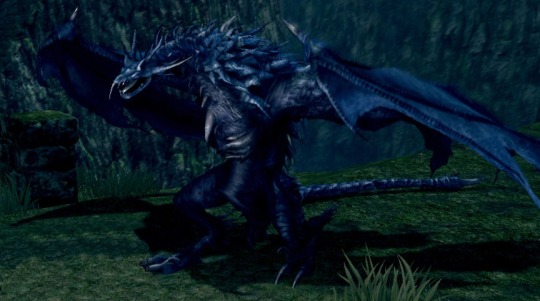
And at the very bottom are the dragons of today. Interchangeably called ‘drakes’ or ‘wyverns’, they have two wings and two legs; a paltry four limbs compared to the Everlasting. The Hellkite is a dangerous enemy, but the Blues are easy pickings for the patient knight. Ornstein hunts them for sport. (Have to guess that he must have started slacking off if something as big as the Hellkite could grow up there.) Even their habitat doesn’t acknowledge them as dragons; it’s ‘Valley of the Drakes’, not ‘Valley of the Dragons’. In essence, the Everlasting Dragons devolved; over the generations, they became less and less until their current descendants are no better than animals. Could it get any lower than this?
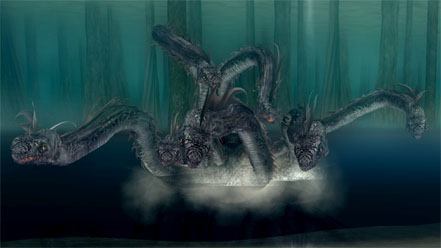
The answer is yes. The hydra is barely even acknowledged as a pseudo-dragon. The only thing that even ties them to dragons is that they drop dragon scales and are in the vicinity of dragons or something that a dragon made. It has no limbs, unless you count its ray-like flippers, and a bunch of seemingly useless tendrils hanging off it. I’ll be honest, the hydras kind of piss me off; the one in Darkroot I can understand, but how the Hell did one get into Ash Lake? It’s one thing for basilisks and mushroom folk to be there; they came in through the arch-tree. But how did a sixty foot long aquatic reptile get there?
I don’t know; frankly, I don’t think there is an answer. The best I can come up with riffs from Norse mythology. If we assume that the arch-tree is Yggdrasil, then the Stone Dragon is Nidhoggr, the dragon at the bottom of the world. In some versions of the myth, Nidhoggr is surrounded by a nest of lesser serpents. So the hydra is the Stone Dragon’s guardian? Offspring?
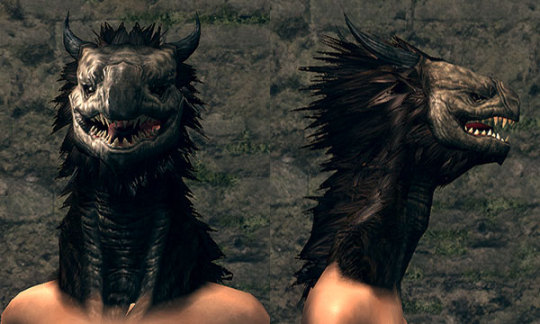
I guess I’m not really talking about all the dragons of Dark Souls if I don’t talk about the Path of the Dragon covenant as well. It really is kind of analagous to Buddhism in a weird way; through the Stone Dragon, you can escape the cycle of life and death, becoming, like the Everlasting Dragons themselves, something beyond any of the Lord Souls. In a way, it’s perfect for Undead; as a being already outside the cycle of life and death, an Undead is closer to escaping it than almost any other creature in Lordran. All they would need would be that final push to make the transformation a permanent part of themselves.
Of course, there may be a more petty side to the covenant; given that the covenant operates on dragon scales, it might be that the Stone Dragon intends for its servants to hunt down lesser dragons like the drakes and hydras. There’s no evidence to that, however, and it frankly seems beneath the Stone Dragon. Remember, its motivations and mindset are unknowable to anything derived from the Lord Souls. Petty vengeance doesn’t seem like it’s M.O.
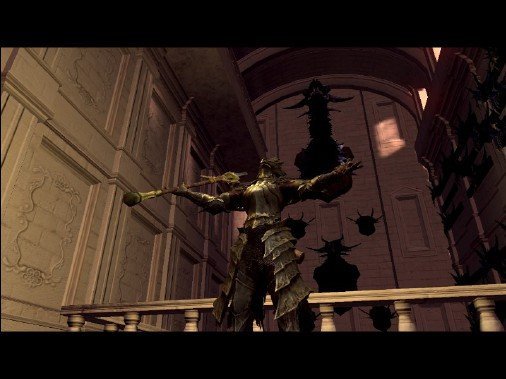
So what’s all this add up to? Nothing much, really. It’s just what motivated the Everlasting Dragons, the setup to the establishing conflict of the Dark Souls mythos. The Dragons weren’t afraid of dying or the Dark; they were afraid of watching their own devolution. Somehow, I think, they knew that the cycle would wear on them, generation after generation, until dragons were little more than animals. Time ruins all things; it’s one of the big recurring themes of the Souls series. Even Dark Souls 2 (which, as I understand it, is stuffed to the gills with dragons) understood that.
The Dragons’ fight was the fight against definition itself; not as simple as stagnation versus chaos, but against the very act of being in and of itself. And I guess that adds up to what’s valued as important in the Souls universe; ‘existence’ is synonymous with ‘definition’. The very act of perception and processing that perception is the heart of reality, a notion that goes all the way back to Demon’s Souls.
Ultimately, like I said, it doesn’t really matter. The dragons are dead, stupid, or in hiding. But they tell us about the tone of the universe, and I had to start somewhere. Thanks for reading this far! Anything to add or ask for the next rambling?
#Dark Souls#Dark Souls lore#everlasting dragon#stone dragon#seath the scaleless#dark souls lore ramblings
291 notes
·
View notes
Link
via RSI Comm-Link
This Galactic Guide originally appeared in Jump Point 4.12.
After nearly six years of work as a stellar surveyor for the Imperial Cartography Center, Usuni Colo had never taken as much as a sick day. By 2941, his supervisor hadn’t suggested that Colo take a vacation, she mandated it. Faced with three weeks of nothing to do, Colo knew there was only one place he wanted to go. Fascinated by the Outsiders, he traveled to Mya in the Leir system to see firsthand how isolationism had affected the planet and its people.
Unfortunately for Colo, his attempts to talk his way past the traveler zone to get the ‘real experience’ got him expelled from the planet. Still faced with a couple weeks of enforced downtime, Colo took his time returning home to the Elysium system. And as a member of an ICC Stellar Surveyor team, he was in the habit of scanning for jump points even when off-duty.
So on 2941.03.11 when his scanners hit an anomaly that looked like a new jump point leaving the Leir system, Usuni Colo was professional rather than surprised. What would ultimately surprise him would be what lay on the other side. He’d learn that he hadn’t discovered this system at all. Only rediscovered it.
Exploration Excitement
Colo took a number of initial scans of what became known as the Kabal system, which Colo named in honor of the famous 27th century musical group. The scans found a F-type main sequence star, three planets, and an asteroid cluster. Upon returning to UEE space, he immediately reported the discovery and logged a special request that his ICC unit be assigned to scan and explore the system he discovered. The UEE granted Colo’s petition, and he returned to the system with the rest of his team shortly thereafter.
Their initial assessment of the system was overwhelmingly positive. Kabal II and Kabal III were located within the habitable zone, and Kabal III’s oxygen-based atmosphere meant it had the potential to be a turnkey planet. Excitement swelled among government officials, since finding a naturally habitable world would provide incredible benefits and resources without the expense of terraforming. Colo and the rest of his team were immediately deployed to take more detailed scans of Kabal III.
The ICC’s standard protocol is to keep the initial assessment of systems confidential until further evaluations have been made and details verified. Yet, somehow Kabal’s assessment leaked. News about the existence of a planet that might be immediately habitable caused a media sensation.
Critics of Imperator Costigan were suspicious; they claimed the leak was a calculated move on the part of his administration. Only weeks prior, the Historical Truth Act of 2941 declassified a trove of documents, many of which were from the Messer era and revealed many of the propaganda techniques Messer’s government used to manipulate the public. Although this was hardly a new revelation and obviously none of the released documents directly related to Costigan’s administration, columnists and critics drew tenuous comparisons between the tactics previously used and actions of the current administration, which had been mired in a series of embarrassing gaffes. The leak of Kabal’s initial assessment was seen by some as a way to get the populace to focus on the UEE’s future instead of the past.
Once the confidential report leaked, the ICC decided to embrace the buzz being generated. Usuni Colo was even scheduled to tell his incredible discovery story to Beck Russum for an Empire Report exclusive. The event was hyped across the spectrum for days, then abruptly canceled. When no official explanation was given for the interview getting canned, rumors started to swirl. After the official assessment of the Kabal system was delayed, also for unspecified reasons, the Senate Subcommittee of the Interior decided to get involved.
The Known Unknown
In October of 2941, Rebecca Alves, chair of the ICC, was summoned before the Senate Subcommittee of the Interior to discuss her stewardship of the agency. Senators focused their inquiries on Kabal III and wondered why the system‘s official report was late. Alves dodged most questions, claiming she couldn’t discuss specifics until the official report was released. When pressed, Alves became more evasive. This drew ire from Senators, who openly wondered who was really running the ICC if its director couldn’t provide a timeline.
Alves’ appearance before the Senate subcommittee was considered a disaster. It re-energized the debate over Kabal and reinforced the claim that the Imperator was really controlling the release of information. Faced with mounting public pressure the ICC finally published their official assessment of the Kabal system in early November of 2941. Suddenly, it became obvious why there was so much secrecy surrounding the system.
The report revealed that ancient, abandoned Tevarin cities, believed to predate the First Tevarin War, were discovered on Kabal III. So, even though the planet was Human-habitable, no settlements would be established for the foreseeable future. Following the release of this report, the UEE government classified the entire system off limits to the public to maintain the integrity of this important archaeological site. It has remained restricted ever since.
Kabal I
This small, lumpy protoplanet sits so close to the system’s sun that it only takes 34 standard days to complete its orbit.
Kabal II
The ICC’s initial report on Kabal II drew comparison to Mars. It’s a terrestrial desert planet situated smack dab in the middle of the habitable zone, making it an ideal terraforming candidate. Yet, the Tevarin never mastered terraforming technology, so it remained uninhabited while the system was under their control.
Kabal III
Kabal III was the system’s clear gem when it was (re)discovered. Yet the hope of the UEE establishing settlements on the planet was quickly squashed after abandoned Tevarin cities were uncovered, turning the planet into an archaeological site.
Beneath a thick layer of native plant life that had reclaimed the cities, this Tevarin world was stuck in time. Buildings and houses were filled with various common goods. Ships sat quietly on landing pads. The sacred codices of Rijora still hung in the temples. All this evidence suggested that the population either left quickly or planned to come back. Either way, Kabal III opened a window into a culture that had tried to erase itself in the Purge after the Second Tevarin War.
The UEE military invited Esperia, the noted ship replica manufacturer, to visit the planet to catalogue and appraise the ships that were found. After comparing them with the few remaining historical records, Esperia estimated that the planet was abandoned prior to the First Tevarin War. Despite providing a treasure trove of historical information on the Tevarin, these cities raised more questions than answers. One in particular remained elusive: why did the Tevarin leave?
Many still wonder how an entire system could have been forgotten by the Tevarin. Most believe a confluence of calamitous events over two centuries — the First & Second Tevarin Wars followed by the Purge — erased the system’s existence from the Tevarin cultural consciousness. Others insist its existence was a closely guarded secret among Tevarin radicals. Acutely aware of how little they know, UEE researchers have taken a cautious approach with the system. Despite repeated requests from the Tevarin Cultural Preservation Society and the Tevarin advocacy group Nerriva Alle, the UEE has maintained a tightly restricted access to the planet.
TRAVEL WARNING
Since Kabal can only be accessed through the unclaimed Leir system, some have tried to camp out and stalk government convoys to discover the exact coordinates of the jump point. UEE ships have been known to engage suspicious ships in the Leir system that are deemed a threat to the confidentiality of the jump point’s location. So, if a government sends you a warning comm, obey their orders or suffer the consequences.
HEARD IN THE WIND
“If you elect me as your Senator, I will work to help bring my people out of the shadows by rebuilding the beauty of Tevarin culture. This includes designating the lost cities on Kabal III as historical sites, and establishing cultural centers on the planet that will educate future generations of both Human and Tevarin alike.”
– Senator Suj Kossi, campaign speech, Jalan, Elysium, 2946
“The Kabal system is an interesting case. How could an entire system be forgotten about in only a few centuries? Could collective cultural amnesia really run this deep, or is there something else going on here? To be honest, I don’t know what answer scares me more.”
– Professor Vincent Fontana, excerpt from a speech to the Tevarin Cultural Preservation Society, 2943
0 notes
Text
RSI Comm-Link: Galactic Guide: Kabal System
This Galactic Guide originally appeared in Jump Point 4.12.
After nearly six years of work as a stellar surveyor for the Imperial Cartography Center, Usuni Colo had never taken as much as a sick day. By 2941, his supervisor hadn’t suggested that Colo take a vacation, she mandated it. Faced with three weeks of nothing to do, Colo knew there was only one place he wanted to go. Fascinated by the Outsiders, he traveled to Mya in the Leir system to see firsthand how isolationism had affected the planet and its people.
Unfortunately for Colo, his attempts to talk his way past the traveler zone to get the ‘real experience’ got him expelled from the planet. Still faced with a couple weeks of enforced downtime, Colo took his time returning home to the Elysium system. And as a member of an ICC Stellar Surveyor team, he was in the habit of scanning for jump points even when off-duty.
So on 2941.03.11 when his scanners hit an anomaly that looked like a new jump point leaving the Leir system, Usuni Colo was professional rather than surprised. What would ultimately surprise him would be what lay on the other side. He’d learn that he hadn’t discovered this system at all. Only rediscovered it.
Exploration Excitement
Colo took a number of initial scans of what became known as the Kabal system, which Colo named in honor of the famous 27th century musical group. The scans found a F-type main sequence star, three planets, and an asteroid cluster. Upon returning to UEE space, he immediately reported the discovery and logged a special request that his ICC unit be assigned to scan and explore the system he discovered. The UEE granted Colo’s petition, and he returned to the system with the rest of his team shortly thereafter.
Their initial assessment of the system was overwhelmingly positive. Kabal II and Kabal III were located within the habitable zone, and Kabal III’s oxygen-based atmosphere meant it had the potential to be a turnkey planet. Excitement swelled among government officials, since finding a naturally habitable world would provide incredible benefits and resources without the expense of terraforming. Colo and the rest of his team were immediately deployed to take more detailed scans of Kabal III.
The ICC’s standard protocol is to keep the initial assessment of systems confidential until further evaluations have been made and details verified. Yet, somehow Kabal’s assessment leaked. News about the existence of a planet that might be immediately habitable caused a media sensation.
Critics of Imperator Costigan were suspicious; they claimed the leak was a calculated move on the part of his administration. Only weeks prior, the Historical Truth Act of 2941 declassified a trove of documents, many of which were from the Messer era and revealed many of the propaganda techniques Messer’s government used to manipulate the public. Although this was hardly a new revelation and obviously none of the released documents directly related to Costigan’s administration, columnists and critics drew tenuous comparisons between the tactics previously used and actions of the current administration, which had been mired in a series of embarrassing gaffes. The leak of Kabal’s initial assessment was seen by some as a way to get the populace to focus on the UEE’s future instead of the past.
Once the confidential report leaked, the ICC decided to embrace the buzz being generated. Usuni Colo was even scheduled to tell his incredible discovery story to Beck Russum for an Empire Report exclusive. The event was hyped across the spectrum for days, then abruptly canceled. When no official explanation was given for the interview getting canned, rumors started to swirl. After the official assessment of the Kabal system was delayed, also for unspecified reasons, the Senate Subcommittee of the Interior decided to get involved.
The Known Unknown
In October of 2941, Rebecca Alves, chair of the ICC, was summoned before the Senate Subcommittee of the Interior to discuss her stewardship of the agency. Senators focused their inquiries on Kabal III and wondered why the system‘s official report was late. Alves dodged most questions, claiming she couldn’t discuss specifics until the official report was released. When pressed, Alves became more evasive. This drew ire from Senators, who openly wondered who was really running the ICC if its director couldn’t provide a timeline.
Alves’ appearance before the Senate subcommittee was considered a disaster. It re-energized the debate over Kabal and reinforced the claim that the Imperator was really controlling the release of information. Faced with mounting public pressure the ICC finally published their official assessment of the Kabal system in early November of 2941. Suddenly, it became obvious why there was so much secrecy surrounding the system.
The report revealed that ancient, abandoned Tevarin cities, believed to predate the First Tevarin War, were discovered on Kabal III. So, even though the planet was Human-habitable, no settlements would be established for the foreseeable future. Following the release of this report, the UEE government classified the entire system off limits to the public to maintain the integrity of this important archaeological site. It has remained restricted ever since.
Kabal I
This small, lumpy protoplanet sits so close to the system’s sun that it only takes 34 standard days to complete its orbit.
Kabal II
The ICC’s initial report on Kabal II drew comparison to Mars. It’s a terrestrial desert planet situated smack dab in the middle of the habitable zone, making it an ideal terraforming candidate. Yet, the Tevarin never mastered terraforming technology, so it remained uninhabited while the system was under their control.
Kabal III
Kabal III was the system’s clear gem when it was (re)discovered. Yet the hope of the UEE establishing settlements on the planet was quickly squashed after abandoned Tevarin cities were uncovered, turning the planet into an archaeological site.
Beneath a thick layer of native plant life that had reclaimed the cities, this Tevarin world was stuck in time. Buildings and houses were filled with various common goods. Ships sat quietly on landing pads. The sacred codices of Rijora still hung in the temples. All this evidence suggested that the population either left quickly or planned to come back. Either way, Kabal III opened a window into a culture that had tried to erase itself in the Purge after the Second Tevarin War.
The UEE military invited Esperia, the noted ship replica manufacturer, to visit the planet to catalogue and appraise the ships that were found. After comparing them with the few remaining historical records, Esperia estimated that the planet was abandoned prior to the First Tevarin War. Despite providing a treasure trove of historical information on the Tevarin, these cities raised more questions than answers. One in particular remained elusive: why did the Tevarin leave?
Many still wonder how an entire system could have been forgotten by the Tevarin. Most believe a confluence of calamitous events over two centuries — the First & Second Tevarin Wars followed by the Purge — erased the system’s existence from the Tevarin cultural consciousness. Others insist its existence was a closely guarded secret among Tevarin radicals. Acutely aware of how little they know, UEE researchers have taken a cautious approach with the system. Despite repeated requests from the Tevarin Cultural Preservation Society and the Tevarin advocacy group Nerriva Alle, the UEE has maintained a tightly restricted access to the planet.
TRAVEL WARNING
Since Kabal can only be accessed through the unclaimed Leir system, some have tried to camp out and stalk government convoys to discover the exact coordinates of the jump point. UEE ships have been known to engage suspicious ships in the Leir system that are deemed a threat to the confidentiality of the jump point’s location. So, if a government sends you a warning comm, obey their orders or suffer the consequences.
HEARD IN THE WIND
“If you elect me as your Senator, I will work to help bring my people out of the shadows by rebuilding the beauty of Tevarin culture. This includes designating the lost cities on Kabal III as historical sites, and establishing cultural centers on the planet that will educate future generations of both Human and Tevarin alike.”
– Senator Suj Kossi, campaign speech, Jalan, Elysium, 2946
“The Kabal system is an interesting case. How could an entire system be forgotten about in only a few centuries? Could collective cultural amnesia really run this deep, or is there something else going on here? To be honest, I don’t know what answer scares me more.”
– Professor Vincent Fontana, excerpt from a speech to the Tevarin Cultural Preservation Society, 2943
http://bit.ly/2C7CWsh
0 notes
Text
Galactic Guide: Kabal System
This Galactic Guide originally appeared in Jump Point 4.12.
After nearly six years of work as a stellar surveyor for the Imperial Cartography Center, Usuni Colo had never taken as much as a sick day. By 2941, his supervisor hadn’t suggested that Colo take a vacation, she mandated it. Faced with three weeks of nothing to do, Colo knew there was only one place he wanted to go. Fascinated by the Outsiders, he traveled to Mya in the Leir system to see firsthand how isolationism had affected the planet and its people.
Unfortunately for Colo, his attempts to talk his way past the traveler zone to get the ‘real experience’ got him expelled from the planet. Still faced with a couple weeks of enforced downtime, Colo took his time returning home to the Elysium system. And as a member of an ICC Stellar Surveyor team, he was in the habit of scanning for jump points even when off-duty.
So on 2941.03.11 when his scanners hit an anomaly that looked like a new jump point leaving the Leir system, Usuni Colo was professional rather than surprised. What would ultimately surprise him would be what lay on the other side. He’d learn that he hadn’t discovered this system at all. Only rediscovered it.
Exploration Excitement
Colo took a number of initial scans of what became known as the Kabal system, which Colo named in honor of the famous 27th century musical group. The scans found a F-type main sequence star, three planets, and an asteroid cluster. Upon returning to UEE space, he immediately reported the discovery and logged a special request that his ICC unit be assigned to scan and explore the system he discovered. The UEE granted Colo’s petition, and he returned to the system with the rest of his team shortly thereafter.
Their initial assessment of the system was overwhelmingly positive. Kabal II and Kabal III were located within the habitable zone, and Kabal III’s oxygen-based atmosphere meant it had the potential to be a turnkey planet. Excitement swelled among government officials, since finding a naturally habitable world would provide incredible benefits and resources without the expense of terraforming. Colo and the rest of his team were immediately deployed to take more detailed scans of Kabal III.
The ICC’s standard protocol is to keep the initial assessment of systems confidential until further evaluations have been made and details verified. Yet, somehow Kabal’s assessment leaked. News about the existence of a planet that might be immediately habitable caused a media sensation.
Critics of Imperator Costigan were suspicious; they claimed the leak was a calculated move on the part of his administration. Only weeks prior, the Historical Truth Act of 2941 declassified a trove of documents, many of which were from the Messer era and revealed many of the propaganda techniques Messer’s government used to manipulate the public. Although this was hardly a new revelation and obviously none of the released documents directly related to Costigan’s administration, columnists and critics drew tenuous comparisons between the tactics previously used and actions of the current administration, which had been mired in a series of embarrassing gaffes. The leak of Kabal’s initial assessment was seen by some as a way to get the populace to focus on the UEE’s future instead of the past.
Once the confidential report leaked, the ICC decided to embrace the buzz being generated. Usuni Colo was even scheduled to tell his incredible discovery story to Beck Russum for an Empire Report exclusive. The event was hyped across the spectrum for days, then abruptly canceled. When no official explanation was given for the interview getting canned, rumors started to swirl. After the official assessment of the Kabal system was delayed, also for unspecified reasons, the Senate Subcommittee of the Interior decided to get involved.
The Known Unknown
In October of 2941, Rebecca Alves, chair of the ICC, was summoned before the Senate Subcommittee of the Interior to discuss her stewardship of the agency. Senators focused their inquiries on Kabal III and wondered why the system‘s official report was late. Alves dodged most questions, claiming she couldn’t discuss specifics until the official report was released. When pressed, Alves became more evasive. This drew ire from Senators, who openly wondered who was really running the ICC if its director couldn’t provide a timeline.
Alves’ appearance before the Senate subcommittee was considered a disaster. It re-energized the debate over Kabal and reinforced the claim that the Imperator was really controlling the release of information. Faced with mounting public pressure the ICC finally published their official assessment of the Kabal system in early November of 2941. Suddenly, it became obvious why there was so much secrecy surrounding the system.
The report revealed that ancient, abandoned Tevarin cities, believed to predate the First Tevarin War, were discovered on Kabal III. So, even though the planet was Human-habitable, no settlements would be established for the foreseeable future. Following the release of this report, the UEE government classified the entire system off limits to the public to maintain the integrity of this important archaeological site. It has remained restricted ever since.
Kabal I
This small, lumpy protoplanet sits so close to the system’s sun that it only takes 34 standard days to complete its orbit.
Kabal II
The ICC’s initial report on Kabal II drew comparison to Mars. It’s a terrestrial desert planet situated smack dab in the middle of the habitable zone, making it an ideal terraforming candidate. Yet, the Tevarin never mastered terraforming technology, so it remained uninhabited while the system was under their control.
Kabal III
Kabal III was the system’s clear gem when it was (re)discovered. Yet the hope of the UEE establishing settlements on the planet was quickly squashed after abandoned Tevarin cities were uncovered, turning the planet into an archaeological site.
Beneath a thick layer of native plant life that had reclaimed the cities, this Tevarin world was stuck in time. Buildings and houses were filled with various common goods. Ships sat quietly on landing pads. The sacred codices of Rijora still hung in the temples. All this evidence suggested that the population either left quickly or planned to come back. Either way, Kabal III opened a window into a culture that had tried to erase itself in the Purge after the Second Tevarin War.
The UEE military invited Esperia, the noted ship replica manufacturer, to visit the planet to catalogue and appraise the ships that were found. After comparing them with the few remaining historical records, Esperia estimated that the planet was abandoned prior to the First Tevarin War. Despite providing a treasure trove of historical information on the Tevarin, these cities raised more questions than answers. One in particular remained elusive: why did the Tevarin leave?
Many still wonder how an entire system could have been forgotten by the Tevarin. Most believe a confluence of calamitous events over two centuries — the First & Second Tevarin Wars followed by the Purge — erased the system’s existence from the Tevarin cultural consciousness. Others insist its existence was a closely guarded secret among Tevarin radicals. Acutely aware of how little they know, UEE researchers have taken a cautious approach with the system. Despite repeated requests from the Tevarin Cultural Preservation Society and the Tevarin advocacy group Nerriva Alle, the UEE has maintained a tightly restricted access to the planet.
TRAVEL WARNING
Since Kabal can only be accessed through the unclaimed Leir system, some have tried to camp out and stalk government convoys to discover the exact coordinates of the jump point. UEE ships have been known to engage suspicious ships in the Leir system that are deemed a threat to the confidentiality of the jump point’s location. So, if a government sends you a warning comm, obey their orders or suffer the consequences.
HEARD IN THE WIND
“If you elect me as your Senator, I will work to help bring my people out of the shadows by rebuilding the beauty of Tevarin culture. This includes designating the lost cities on Kabal III as historical sites, and establishing cultural centers on the planet that will educate future generations of both Human and Tevarin alike.”
– Senator Suj Kossi, campaign speech, Jalan, Elysium, 2946
“The Kabal system is an interesting case. How could an entire system be forgotten about in only a few centuries? Could collective cultural amnesia really run this deep, or is there something else going on here? To be honest, I don’t know what answer scares me more.”
– Professor Vincent Fontana, excerpt from a speech to the Tevarin Cultural Preservation Society, 2943
0 notes